30 12 2020
Letter from Near the Close of the Year
I am sitting in a rocking chair by the window, considering
Mid-afternoon light, pale blue sky, and the scud of small clouds
On the day-before-last of this year.
Penultimate.
Indeed.
This, the axis: of this day, of this week, of looking back and forward.
What does ‘hump day’ mean when time is no longer measured by the clock of labour for pay? When the work of a day is to be, to think, to wonder at the small things.
The spider that just announced his presence through jerk-shift-hop movements
across the carpet doesn’t care
what day it is,
nor should he (she?) – only that it might be work to find the next meal, and a place away from the potential of crushing feet. This may take cunning, or speed at least.
I have read that in Nehiyaw traditions, weasel medicine is associated with stealth; with this comes energy & ingenuity. The ears to hear the truth, eyes to see potential, what needs be done, and what is happening beneath the surface.
On the other hand, Inuit myth positions weasel as a wise and brave creature; a hero would transform himself into a weasel when he had to accomplish something requiring bravery.
So, a mixed blessing to be sure – not unlike the experience of living.
You have no mice, but you have weasel-kin settling in for winter.
Your new houseguest has more than one name, as befits such a complex being: sihkos ᓯᐦᑯᐢ in Nehiyawewin, enn blet in Michif; in Northern Michif, also sihkos (plural sihkosak).
I wonder if Michif was spoken on the Lobstick Settlement lands, and if so, which form?
Did the homestead’s land know Cree or Michif as one of the songs its inhabitants voiced to the world?
http://native-american-totems.com/animal-totem-medicines/weasel-native-american-animal-totem/ accessed 28 December 2020
https://www.creedictionary.com accessed 28 December 2020
I've been thinking a great deal about mirrors. How it is that we understand ourselves. Our relationships.
I really didn't know at all what to expect in being placed in a communal living situation for this Spring Intensive; whether I'd become too set in my way of being to be a decent roommate and colleague, or if I could even accomplish anything living in such close quarters ... I am used to solitude, to having silence and physical space to think. I also recognize how introverted I am - my need for space and time and silence to recharge, to be able to be good to the people around me, and to be able to really think about all that is going on.
This is not that.
I am tired. Bone tired ... there's so much input, so fast. And sleep has not come easily, with a brain filled fuller by the day, and feeling overwhelmed by potentials, ideas, getting organized.
But it is good nonetheless. Much more than that, actually. I feel continually blessed by the presence of the people I live with. They are all so very different, as are their practices, but from all of that difference, so many warm and generous conversations have emerged. I feel supported by the close presence of these humans, by their generosity of spirit and thoughtfulness. We show each other things about our respective practices and ways of thinking - so soon, already - the depth and perceptiveness and honestly is humbling. Refreshing in its candour, but also in its kindness. One of many unexpected gifts here.
So I am beginning to see myself differently, see myself reflected differently through this. Understanding that I still need space and time on my own, but that this need is also more elastic than I thought. That I can stretch myself farther than I thought I could, and be active as a listener and support for longer. That's a very welcome revelation.
I felt my chest open up yesterday, in a way I haven't felt for so long. I'd forgotten the feeling, actually, but the physical longing for it was there in my body all the time. A tight hollowness, that oddly, didn't need filling ... what was needed was openness, release, expansion.
A freedom in vulnerability.
This is me as a child, again: outside, trees and plants and rocks and water and animals. I have joked that I was semi-feral ... only half a jest, truth be told. Out of the house, away from people, meant I was ALIVE on a visceral level that I never had words for until much later.
And on this day:
Smell, and being able to detect little changes, new threads to follow. Deep, deep lungsful of air. Touch as communion. As learning new languages and ways of being that I will never know fully, but can wonder at through the tips of my fingers, feet on ground, walking. Sight. Colour and motion, light and how it changes by the moment. The play of sun on water. How the bay water can look like glass and reflect the arc of sky. The particular flat light that can show you the details in a cliff face that would be obscured in a moment if it were brighter. How a particular seaweed dries to a deep, rich red, and then to black. Iodine. Blood. The pulse. Eagles, and the incredible distances they can see. What it means to be a predator, in a visual realm: distance, trajectory, timing, awareness. What it means to be able to launch off a treetop or cliff and trust the strength of the body and unconscious knowing how: to fly, and so embody space in the doing. Taste. Salt on dry lips, the welcome collapse of hunger into food, how everything just tastes better when you eat outside. Food from the place you are, all the more important in making awareness of place and time: mussels, plump and the largest I've ever seen, sweet-salty, lush. Home made baking, an act of care made for all the senses that speaks to small indulgence and home comforts. Hearing: crackle-scrape of boots on gravel beach as companion. The space that sound can make in the day, an aural record of the body's relationship to Earth and distance. How sound travels over water, how wind slices that sound up and disperses it into fragments and rambling, half heard. The abruptness of boat motor as interjection. An insistence that becomes unavoidable, however welcome for the utility it brings, the power to take bodies places in short order.
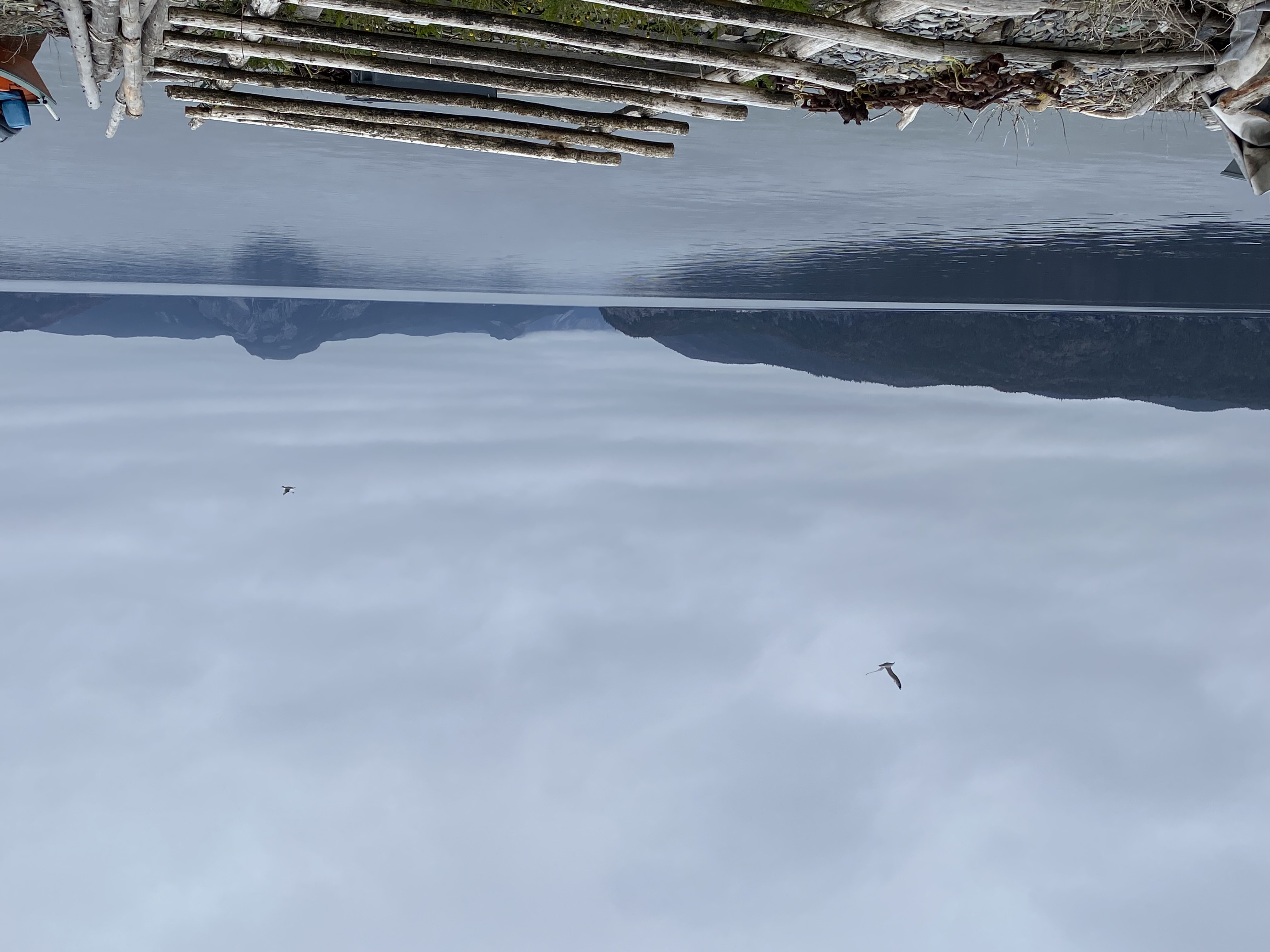
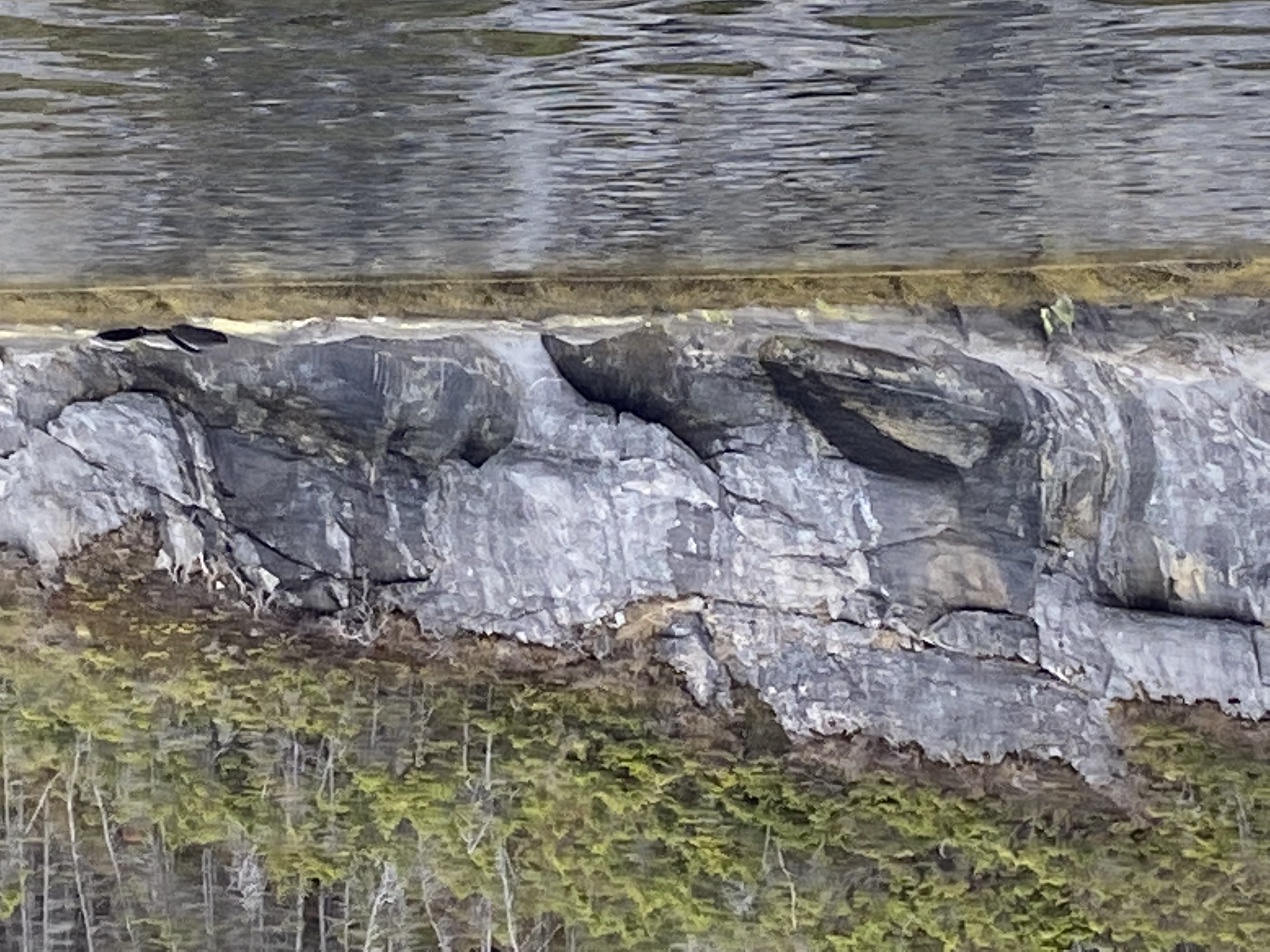
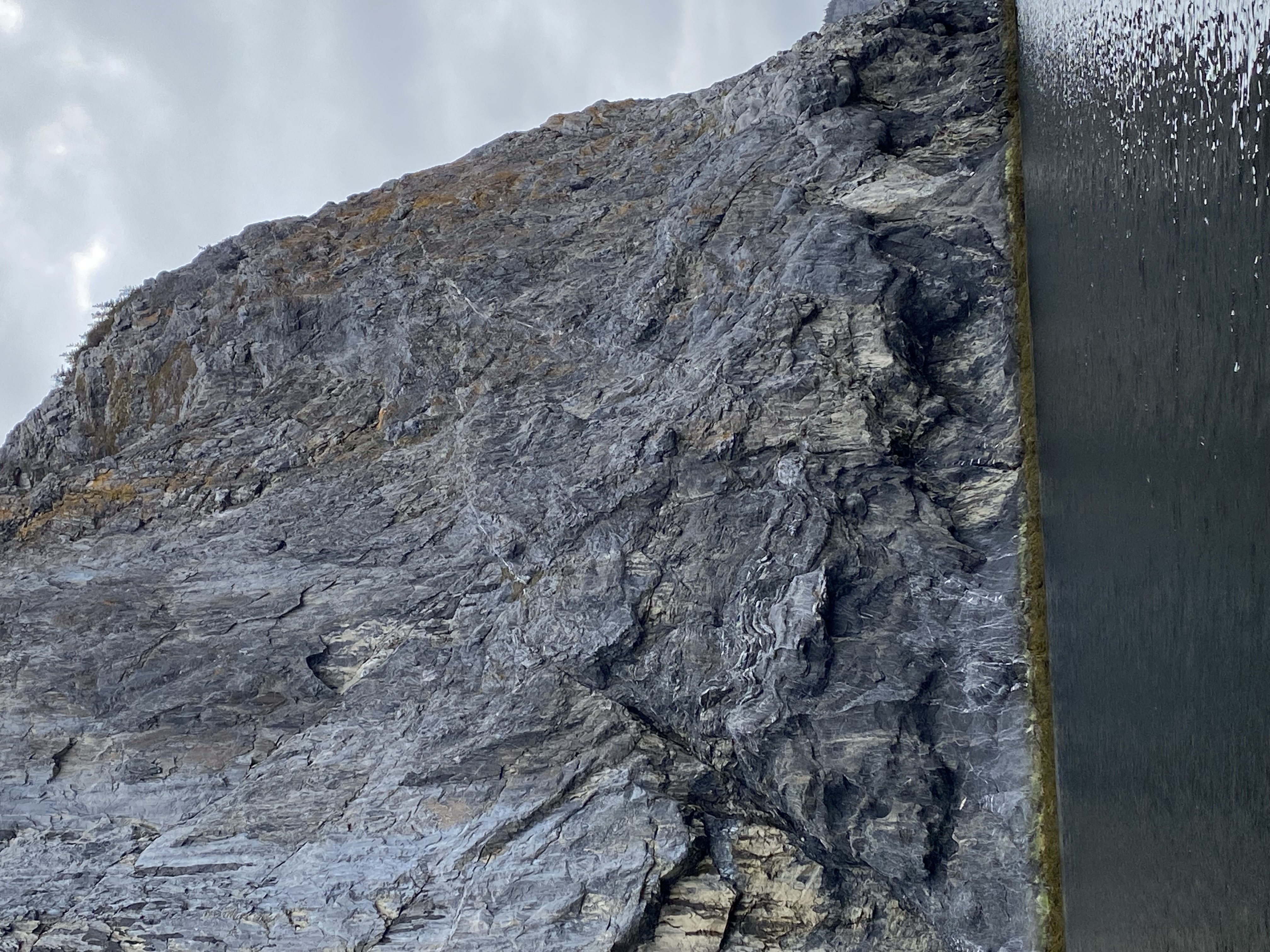
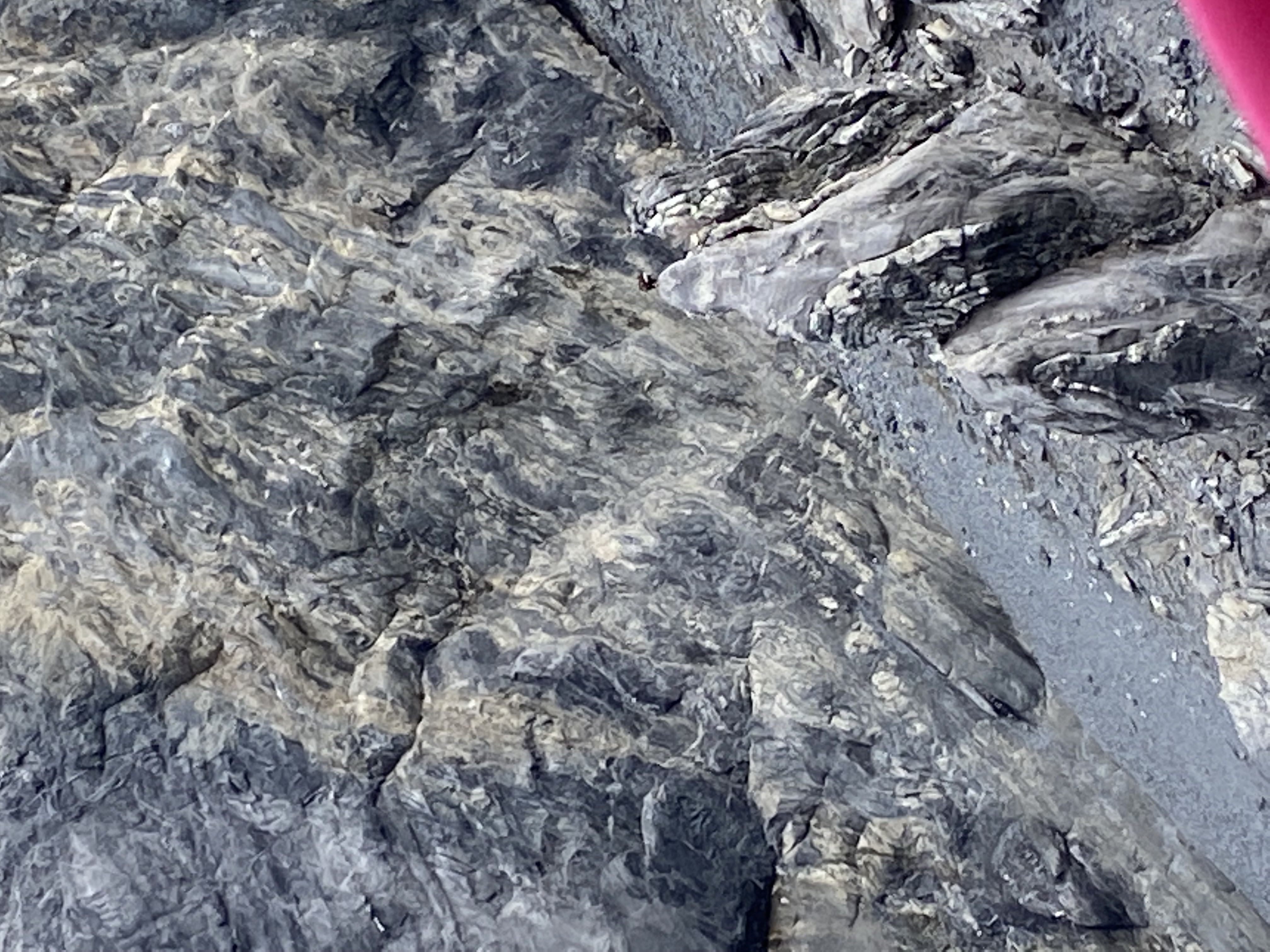
So many textures and colours to absorb. Wished I could reach out and touch every one of them.
Rock, folded like toothpaste or fabric, marking time so vast no
human mind could properly grasp its enormity.
There is something incredibly exhilarating about recognizing how utterly insignificant we all are in relation to the planet's time scale. Even more so, since by the standard of the universe's clock, the Earth itself is young - we are less than an eye's blink here. SO vastly unimportant on one level, so devastating in our impact.
Seeing this landscape from the water only makes these recognitions more apparent.
I don't find this overwhelming - not at all. There's this odd sense of dissolving ... not he right word, but I haven't really found a way to fully express this sensation yet. As though in the face of this immensity, I become nothing - less than nothing - but at the same time so completely a part of what I see before me.
A molecular belonging in some odd sense - a recognition of being so deeply a part of all of it and of so little matter or significance in relation to it at the same time.
The closest I have ever had to an out-of-body experience, I guess, a moment of transcending the limits of the body and being totally conscious of it at the same time.
I'm so grateful for this.
I wonder (and despair): how can anyone see places like this, and not be painfully aware of our complicity in the ongoing damage to the planet and its systems? It's difficult: to know on one level that this is EXACTLY what I needed on a soul-deep level, and recognize that this need has been met through the burning of fossil fuels to get me here, the fabrication and use of plastics to make everything from plane and car parts to some of the components of my clothes. And on and on.
There's no escaping that. So it becomes even more important to me how I make, and what I make. And what that making can contribute toward dialogues about responsibility and complicity as factors in the choices we collectively make on any number of levels.
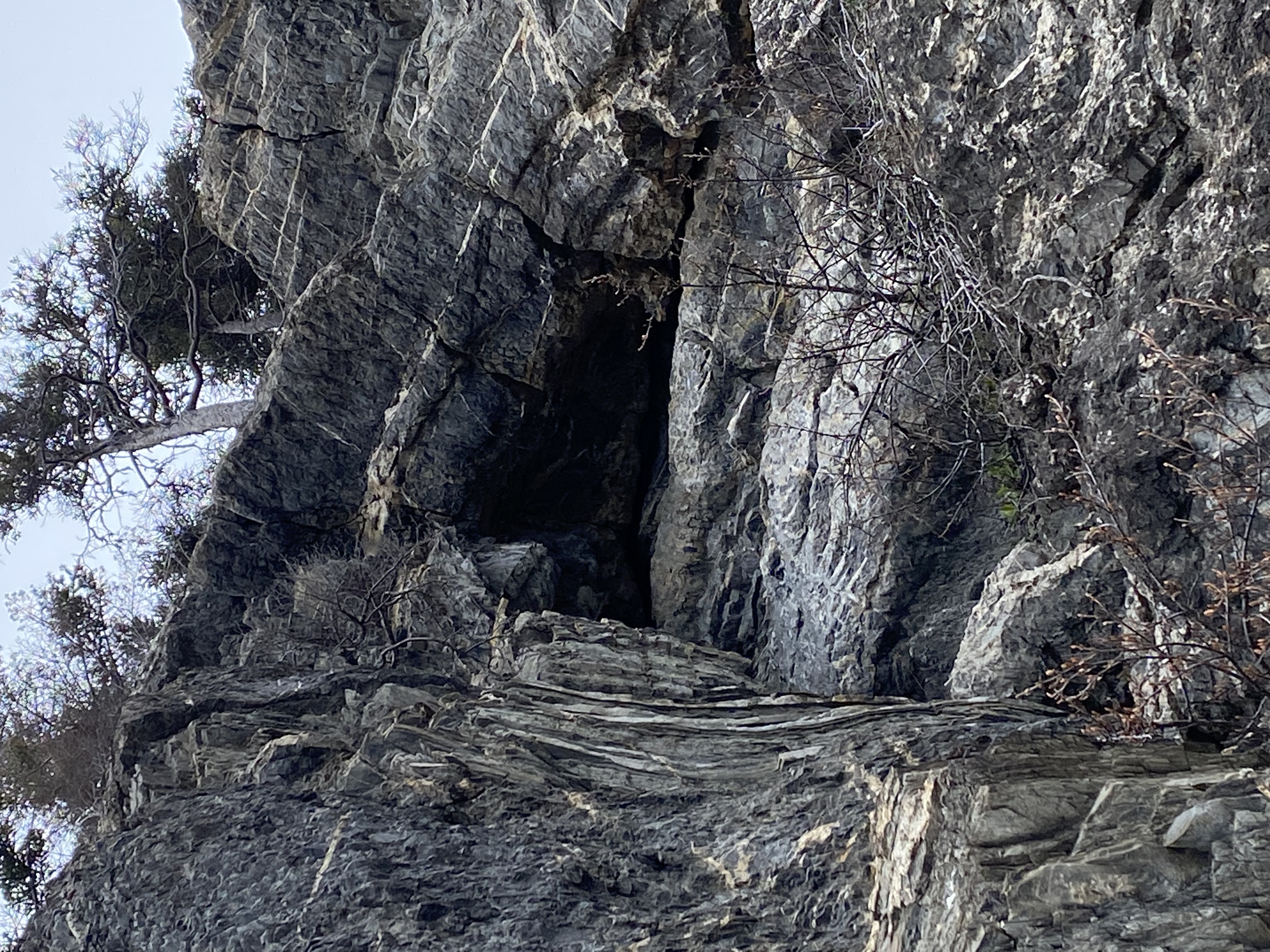
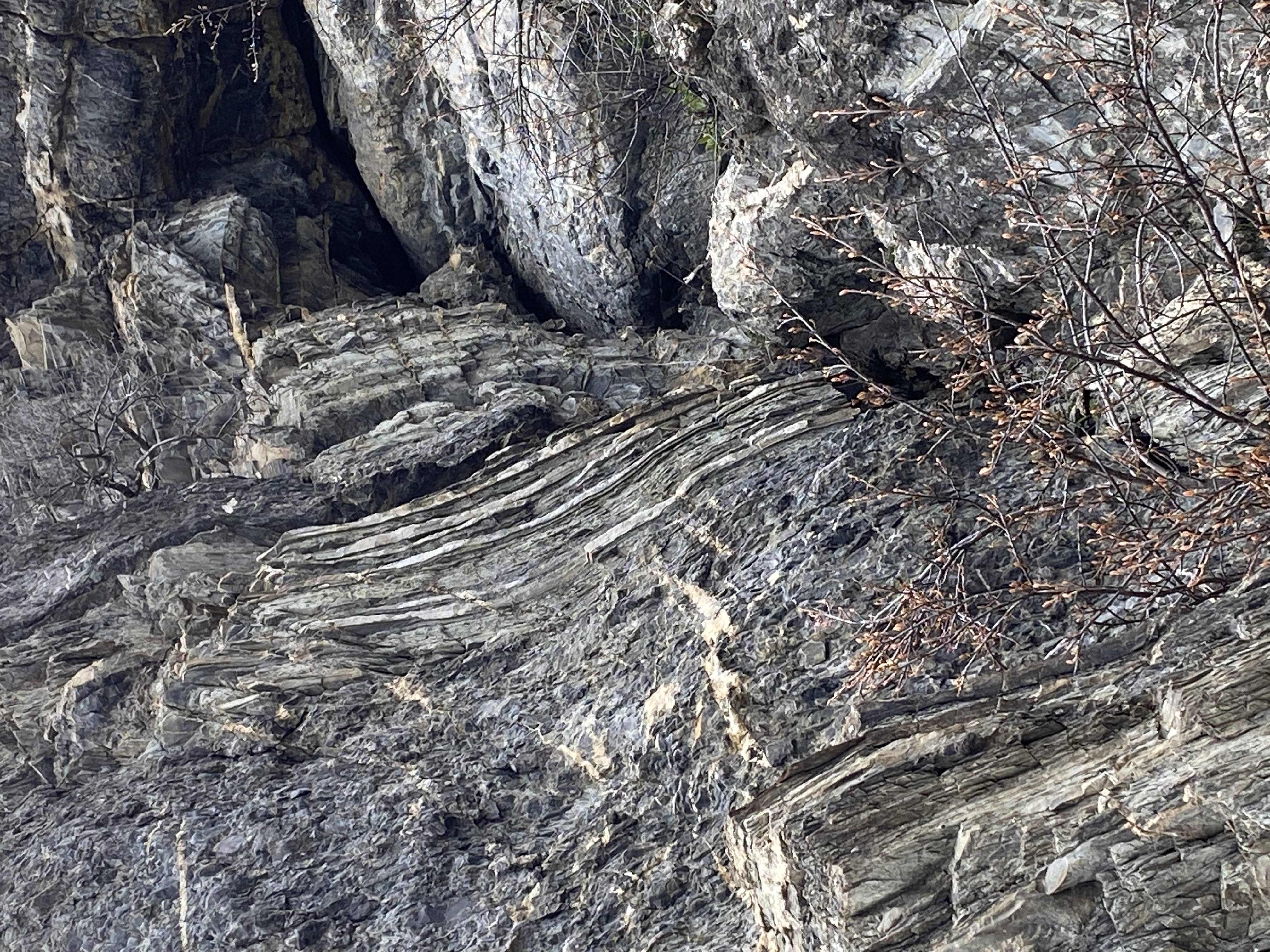

Walking the Line 08 March 2021
Fences turn places into property.
Divided from itself and us, compartmentalized: it’s relation to capital demarcated for all to see. Place becomes land becomes commodity.
Mine and not yours (any more) cut up by neat lines on a map, the work of survey crew and settlement.
Now I understand the term “home place,” but its implication in the settler-colonial endeavour of taking land, erasing its placeness, denigrating relationship, is troubling.
You trouble the problem too: we have read the “history books” and looked up names, fond maps … but who names and who writes makes all the difference. Transgenerational complicity, to be acknowledged. And more.
Who was Chief Bear’s Ears? One line in a book mentions his widow, Violet. Who were their kin? How long did they live in the place the white government named “Indian Reservation No. 126” and how was that earth, those grasses and animals and trees and stories and memories related to the place that was their peoples’ territory?
How like water these things continue to flow, unseen, in and below ground.
I walk. One foot in front of the other through the caragana.
It is not my place, but it is, inside me.
I come to the old fencing that borders the homestead.
Encouraged, always, by the way the trees and bushes,
the wild grass has grown
overthrougharound the wire:
Defiant in the urge to grow, to be, to continue.
I want to be able to push my hands into the loam, stretch my arms, shoulder-deep, into the earth … and do what?
I want to hold the stories to my heart. I want to know, in my flesh, who walked here before me.
Before Terenty.
Before the Surveyors.
… and then?
Open up space. Take down the fence. Make it something else.
Repair-ations to begin again, like the trees and bushes and grass: insisting that there is a better way. In relation.
Feel very much like I am running out of time. That the calendar is not my friend ... it sits on the wall of my room over my shoulder ... alternatively chiding and laughing at me. The hubris of expecting that I'd get more done.
I had the feeling at the outset of this Intensive that there would be more time - or that somehow, time would have a similar shape to it as it did in self isolation ... breathing room.
Of course, this isn't the case.
Always more to do, and finite amounts of energy. This is an ongoing lesson.
I am also aware that a good bit of the pressure I feel is self-induced (as it is for all of us; we have been commiserating about this for a week now) ... we all want to make good work, to do well in the program, to wring whatever we can out of this experience and the access to studios and facilities that it brings; myself included. NO surprise there.
Still, I feel so lucky to be having the adventures that we are having - it's been so welcome, these breaks - and they are opportunities to get out into the places around us, become a little more embedded in this moment, here, and think about where we each might go with what we find.
Good things percolating in the background right now.
I was accepted to a travelling international show organized by the amazing women of Arts Territory Exchange, and discovered images from the exhibition's iteration that the curator had included the piece I submitted. A happy moment for me in the Unboxing Project.
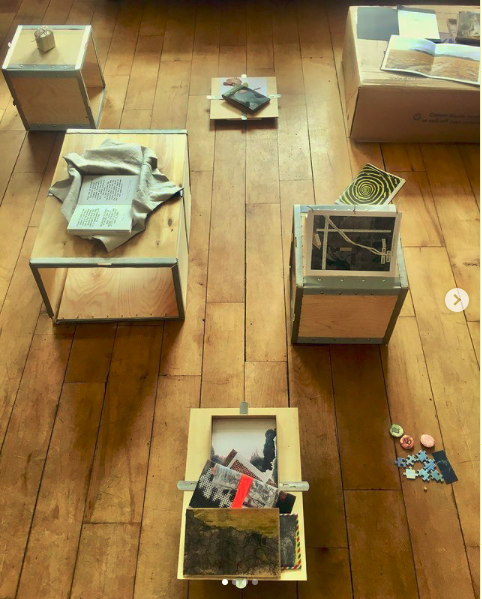
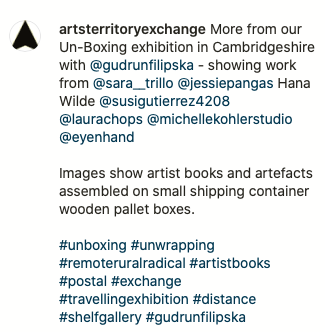
What I want to be able to do is impossible.
To transcend this meat bag and the packaged consciousness within it to be better at respectful relationships with everything around me ... that's not possible on so many levels.
It's not possible. I know that - we are all hidebound in our being. But. BUT.
What I need to do, I think, is really a threefold thing:
find ways to express that desire, and
somehow incorporate my recognition of the impossibility
find ways to invite explorations into the potential offered by what I find in the process of trying.
Working toward a deeper understanding of place and the beings in particular places ... in what I can offer them, not the other way around (or at the very least to minimize what impact I have in the process of discovery).
Awareness: knowing that for me in this moment, every part of the process matters.
How I approach making, and the results of that making are equally important.
I need more time to think this through, much more time, alone in the quiet.
But there are places to start.
What does an invitation to understanding look like?
There's power in seeing yourself reflected in a place, but in a way that disrupts your ideas of who you are and what your responsibilities are. That's mirrors again!
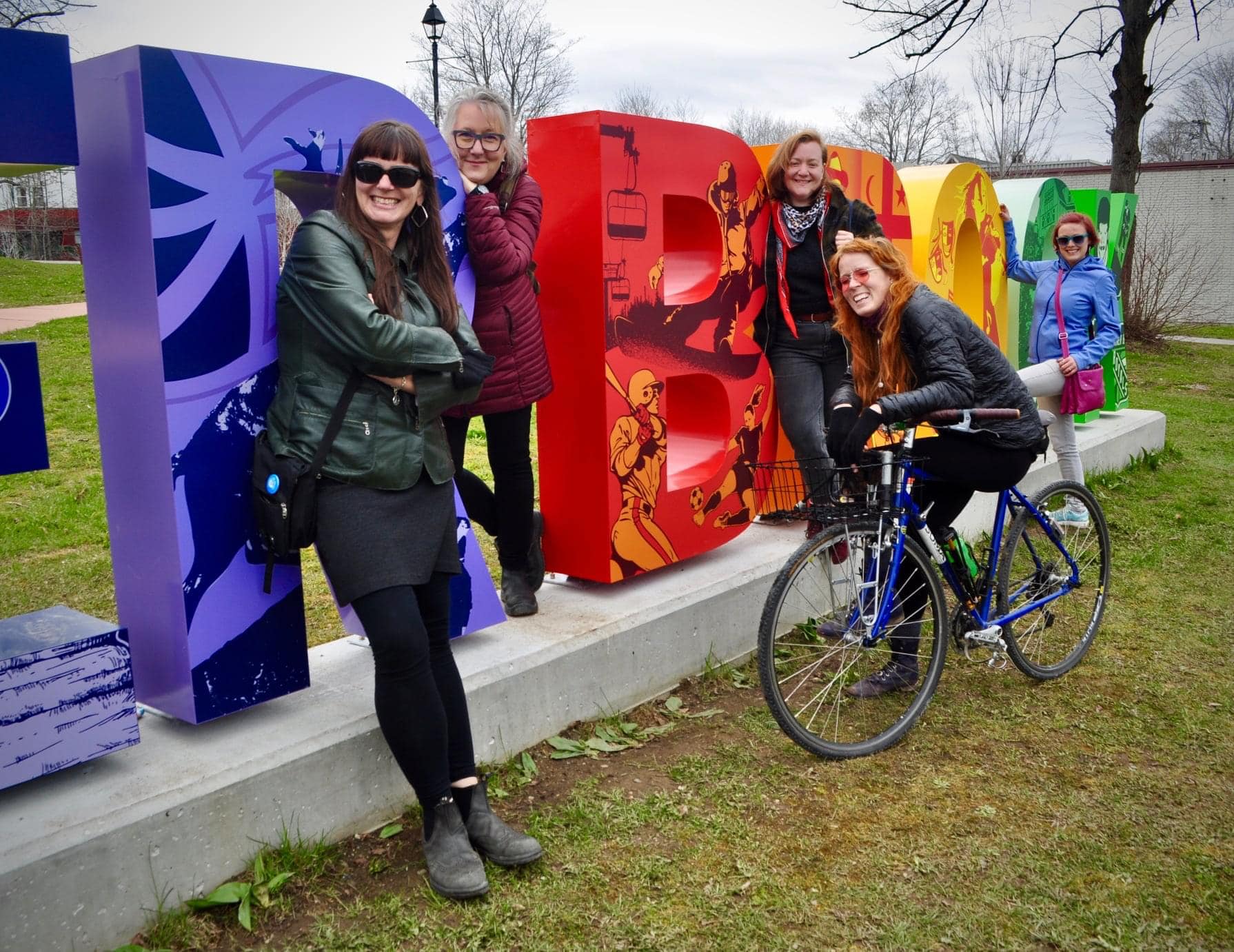
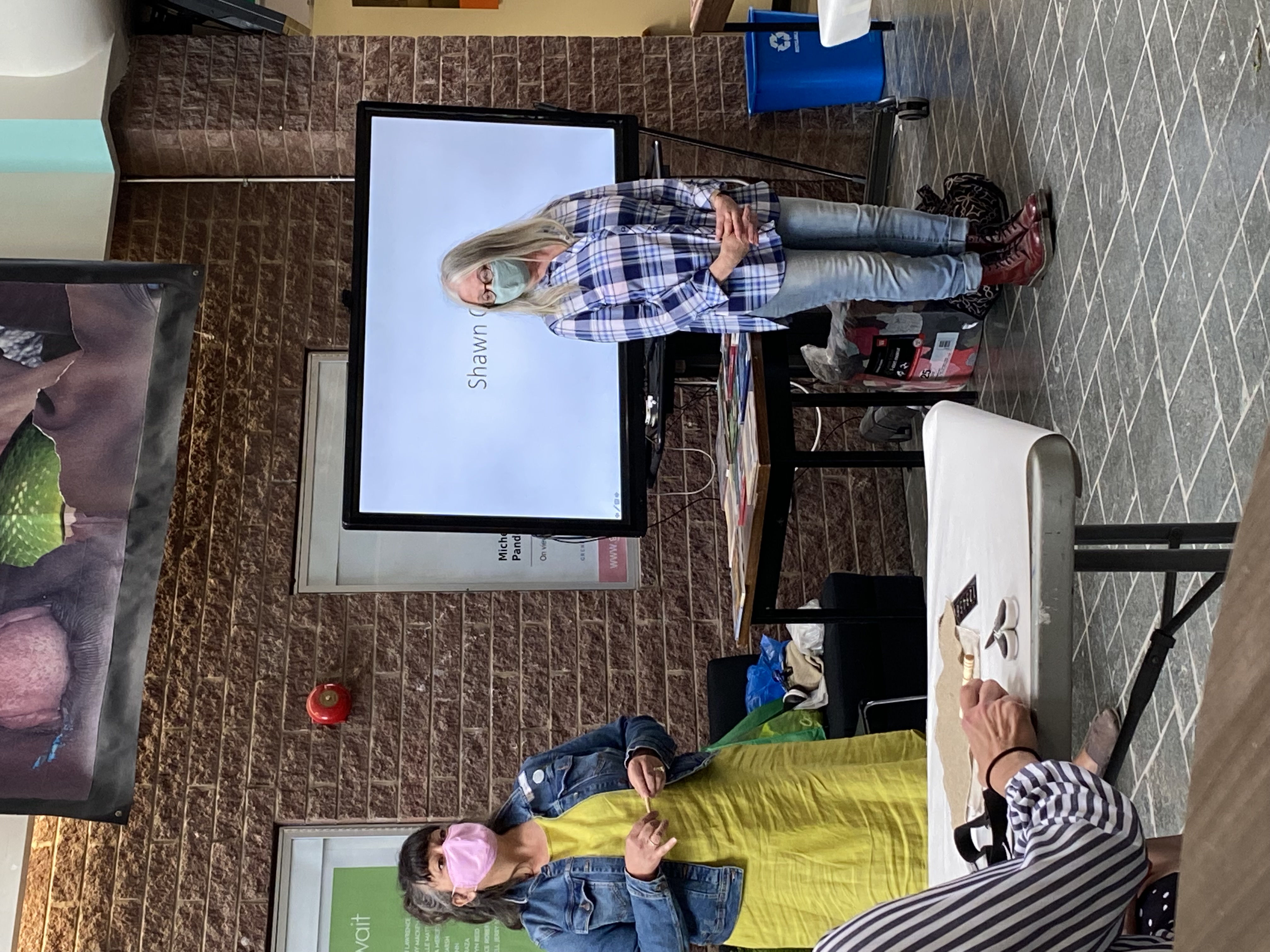
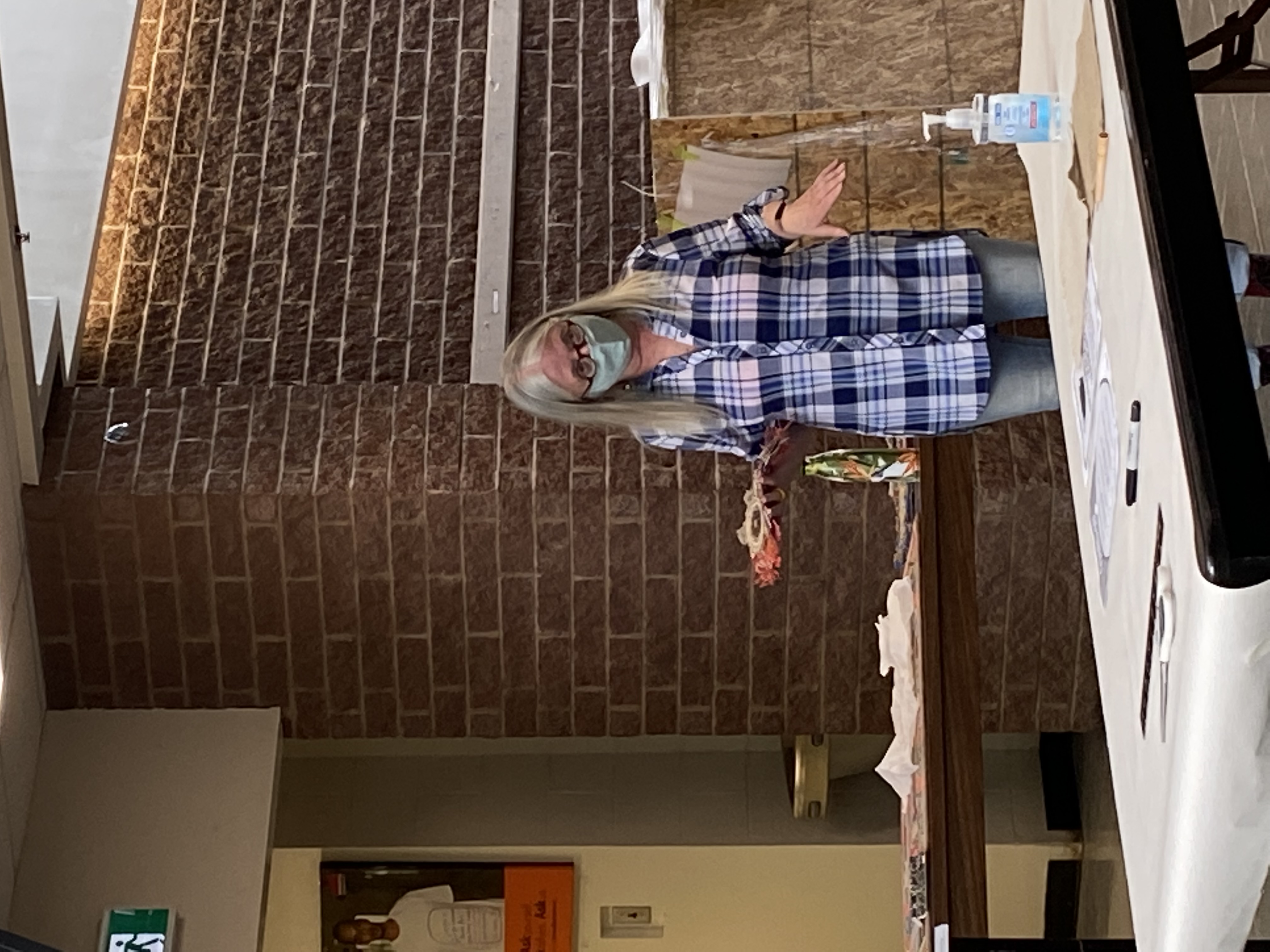
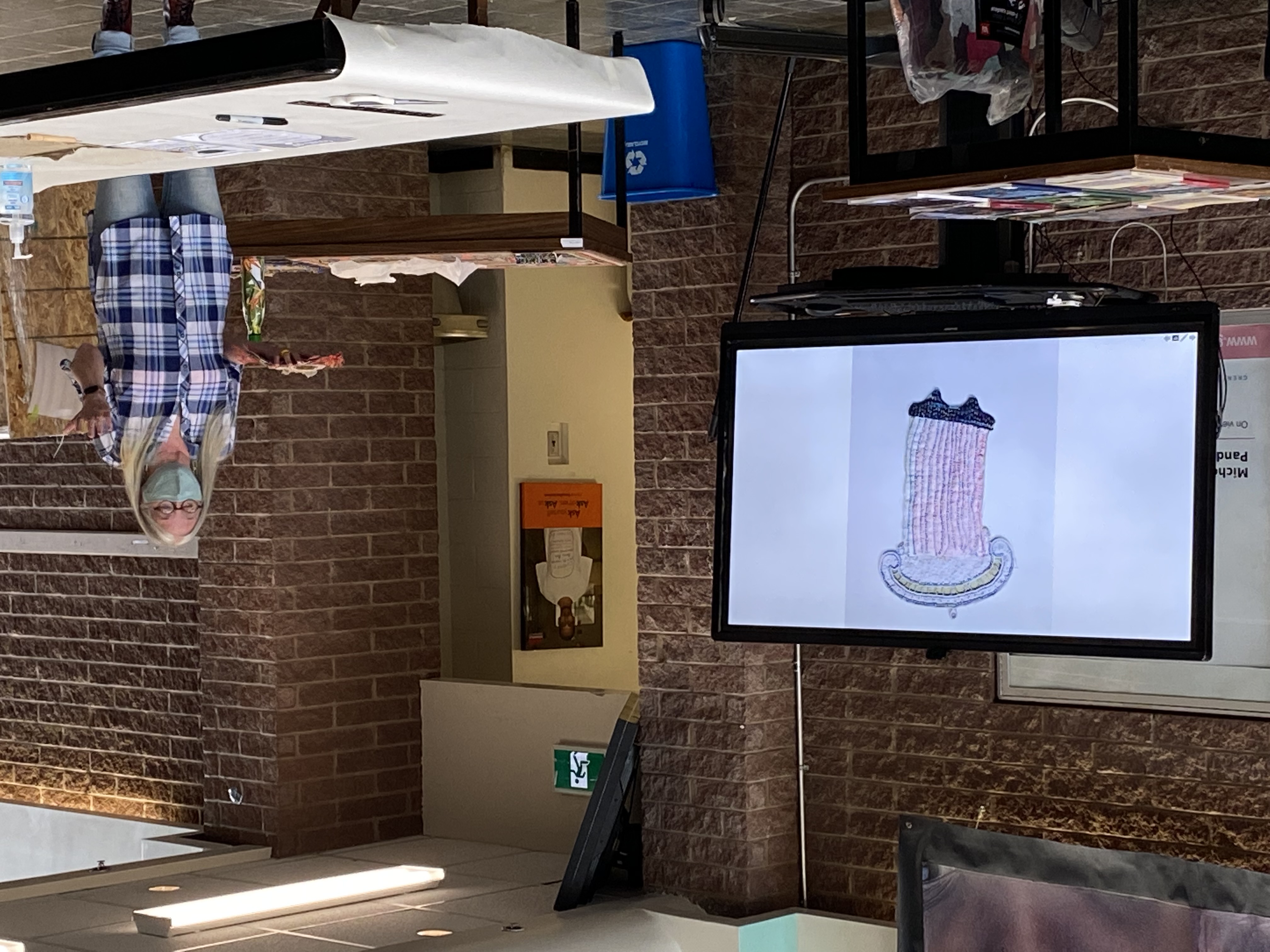

I learned a lot about love today.
What it means to be in an environment where you can be vulnerable, without fear of hurt or betrayal or shame. A new and very delicate thing.
A chest-hurting kind of joy.
What it means to be able to sit with a group of humans for several hours and learn a new skill - and recognize a new part of yourself in the making. To understand this type of making viscerally, as a deep act of love, and to know just as viscerally how important being and doing in the world with this same sort of care in all things is something that I have been striving for.
I wonder if I am brave enough... if I have the courage to stay with being this open.
It feels so very tender. Fragile.
I think that's what it's going to take to do this work. The art yes, it will take this much, certainly (at least,) but the question is larger even than that. It's about the way I live and act in the world for the rest of the time I have.
At the end of the day, I need to be able to look myself in the eye and say I did try my best to do better.
Today I learned that what
my work is really about: love.
The wild is everything that grows and breeds and functions without supervision or imposed control. It is what lives in the long term without being managed.
The wild is not a portfolio of resources for us or our species to buy and sell or manage or squander as we please.
The wild is earth living its life to the full.
The earth's life is much larger than our own lives, but our lives are part of it.
If we take that life, we take our own.
From: Learning to Die: Wisdom in the Age of Climate Change. Robert Bringhurst and Jan Zwicky. P. 12
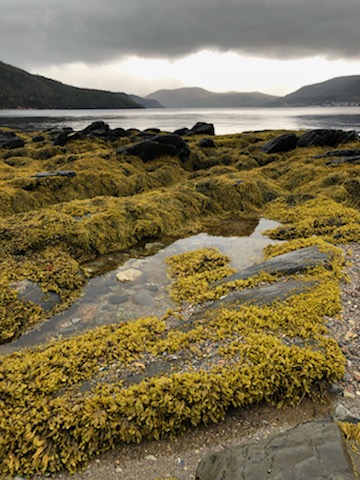
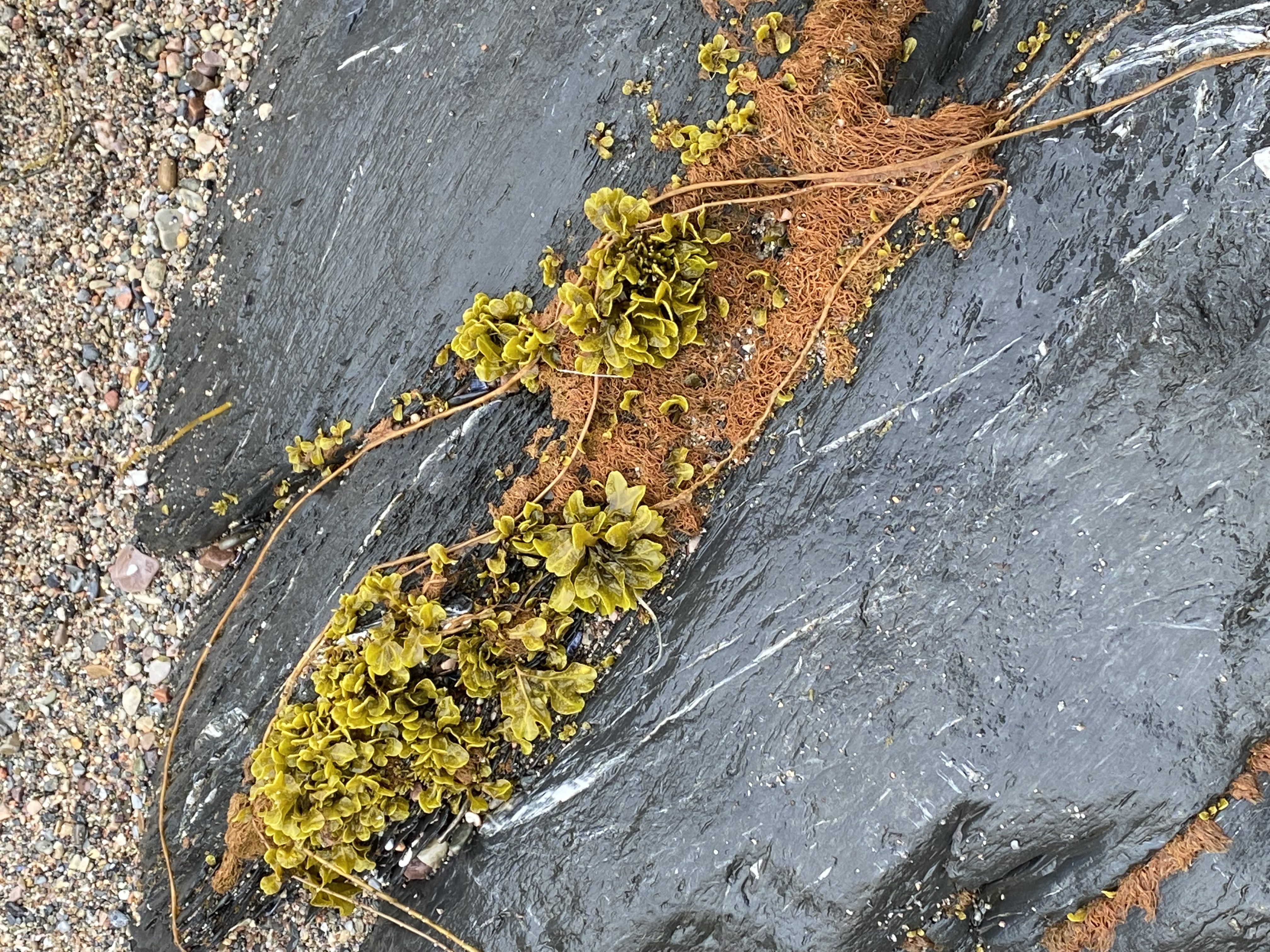
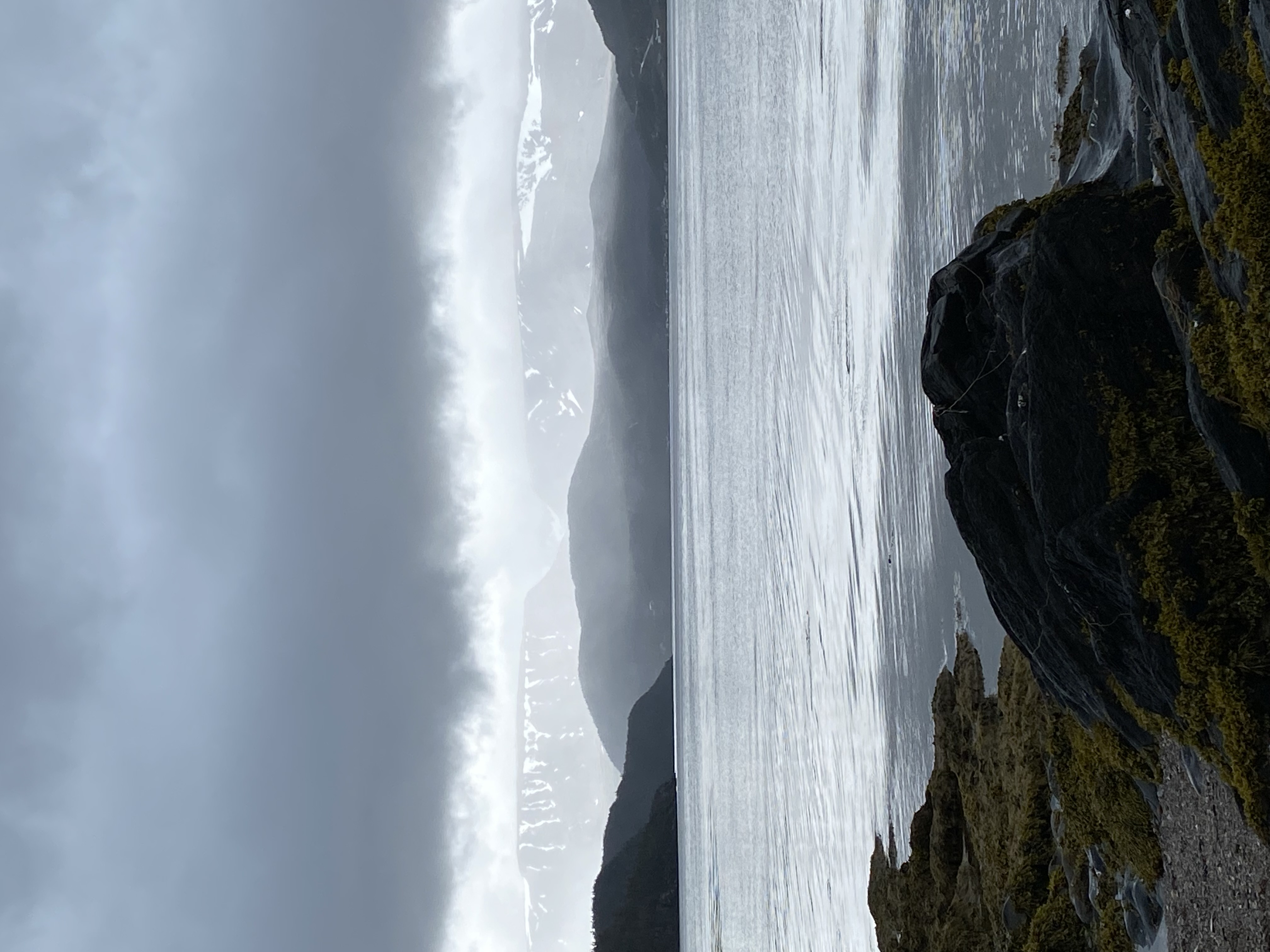
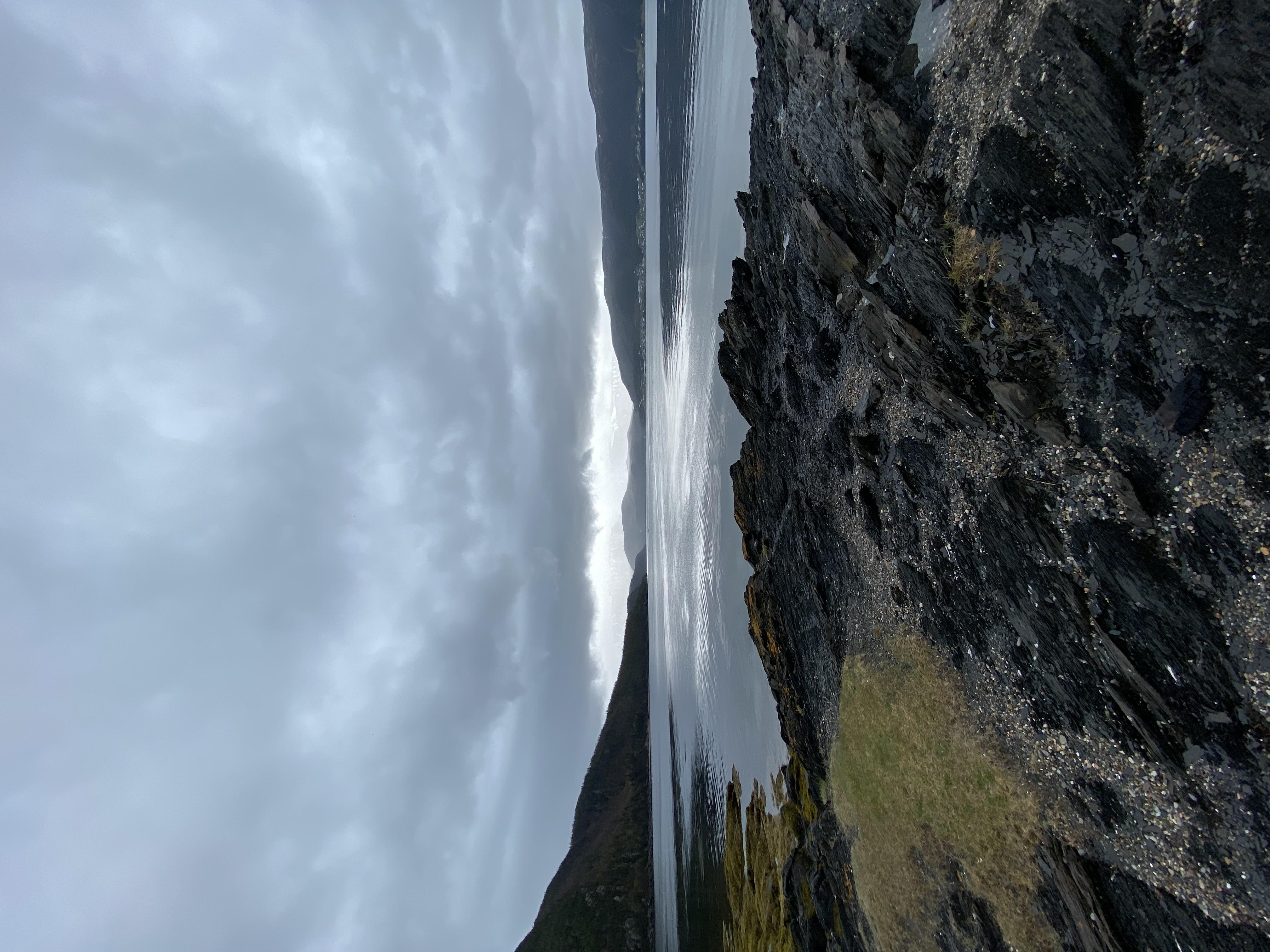
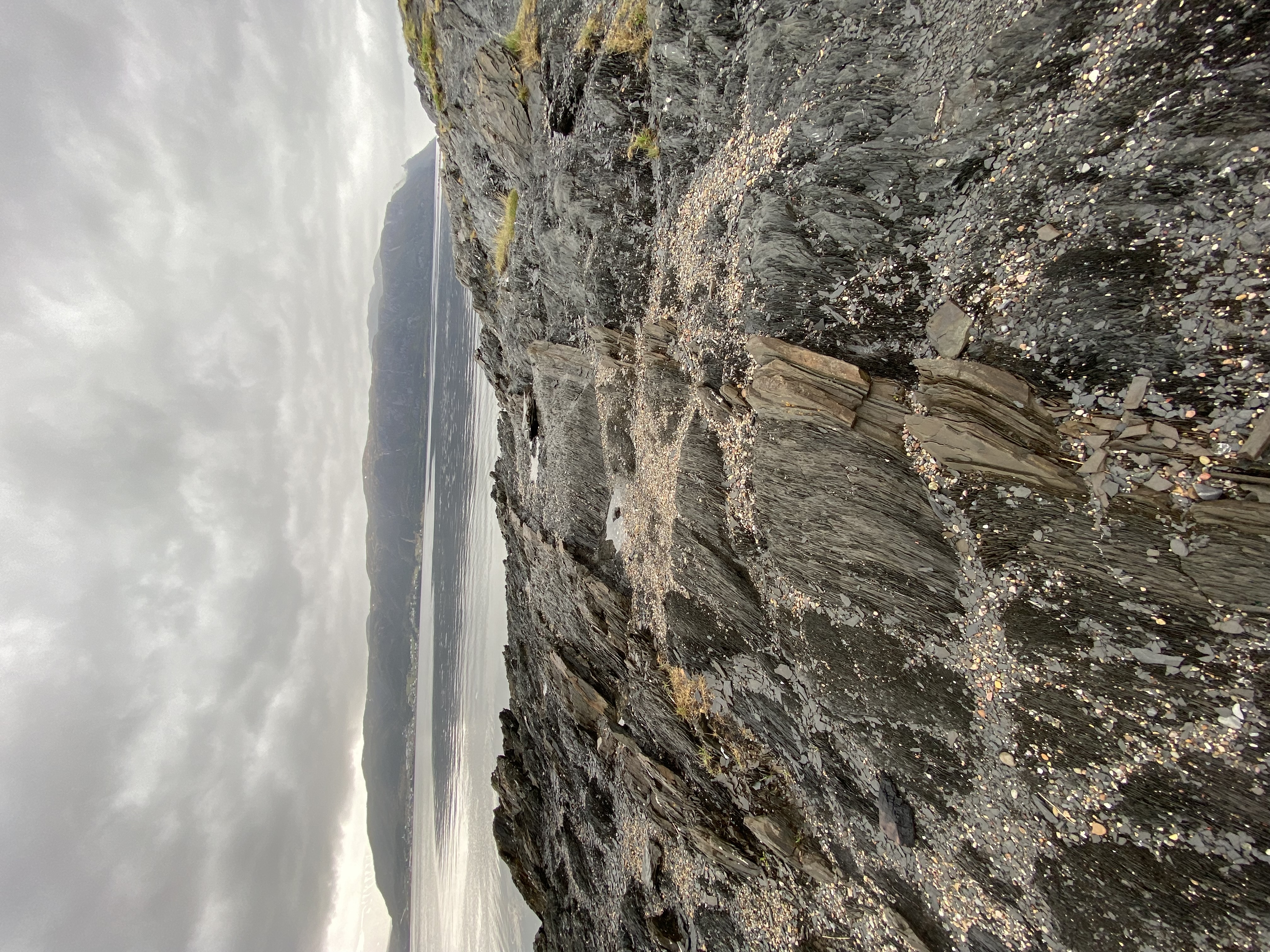
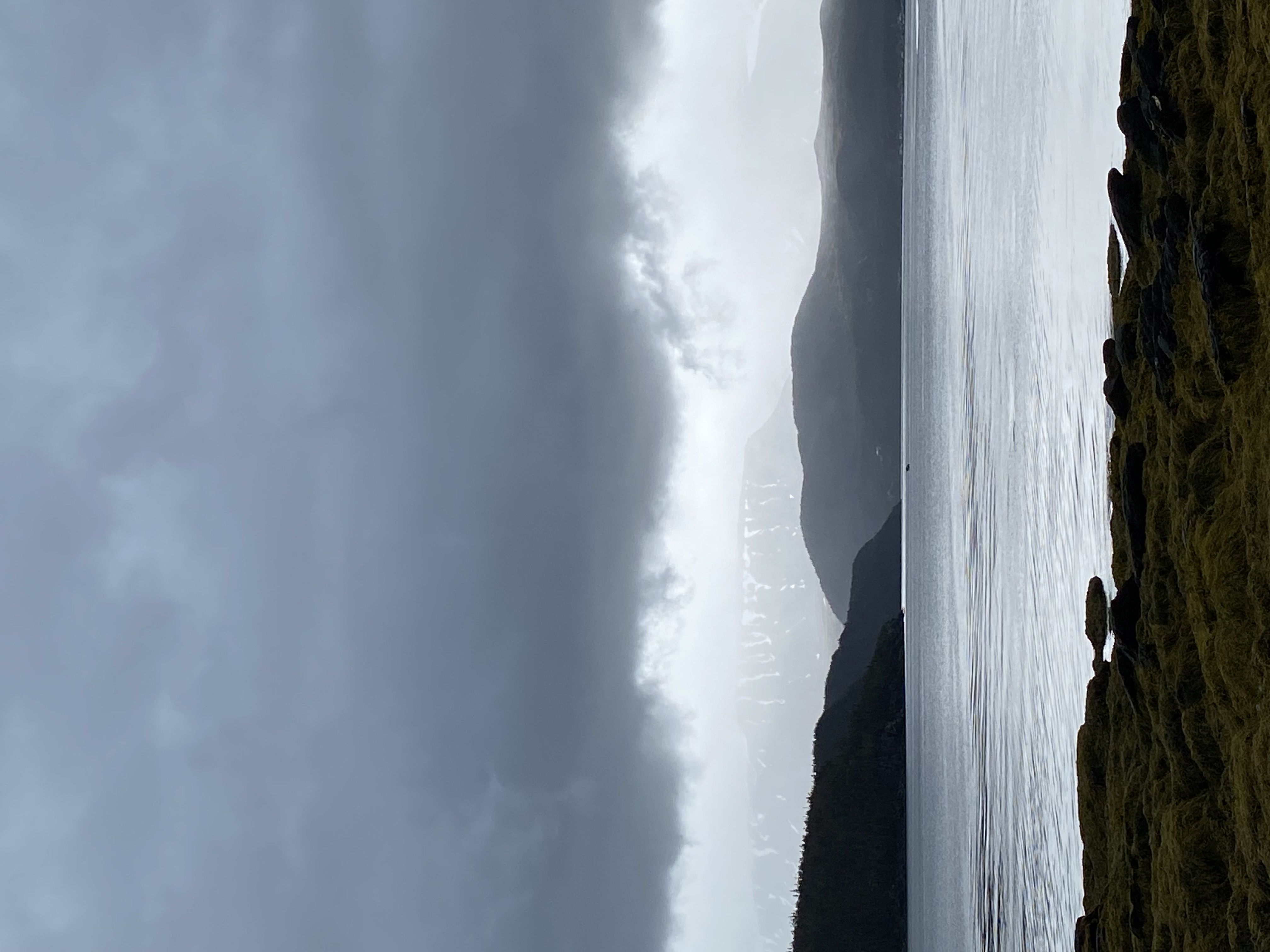
End of the third week of the Intensive, and there's been a palpable shift for me.
I think most of us faced some kind of barrier or reckoning this week - sometimes on several fronts at once. To be expected, but interesting that it all reached a head for the group as a whole at roughly the same time.
Bottomed out mid week, lack of sleep, pain, and over stimulation with no down time ... these all feed each other in a non-productive way, so that wasn't surprising.
Saved by rug hooking ... who knew??
Friday was a much better day, though not much more sleep than other nights, between the gawdawful sadistic mattresses in the chalets and reading at night in the quiet - but - had a great session in the print shop that resulted in very positive test results for the blind embossment I have been wanting to do. So that was a GREAT takeaway, and was inspiring and motivating, for sure. Then met with David to discuss options for laser work on the mirror idea I have ... that was less positive news, but very productive nonetheless. He's been SO helpful already, and WOW what a great source of support and information! He'd even managed to dig up some pricing for me so we could discuss options for materials! Disappointing that the aluminum won't work - it's light and inexpensive (relative to steel) - but the test David did on a bit of steel gave me the kind of result I am looking for - at least, it looks like there's potential here to do what I want. SO that's something good too.
Fantastic meeting with Cam over webex as well - she asks such thoughtful questions, and pointed me in some good directions for other artists to look at and consider.
And today I got a solid 6 hours in the studio before my neck stopped me, and got almost 3/4 of the way through carving a large lino plate for embossing on the press, and also sent Robyn more images for transparency printing for both lino templates and for cyanotype ... so all in all really productive.
Thinking through the making helps so much - but it takes a lot of time and focus for me to see results. I feel like I am stripping down and clarifying my thinking, slowly, and seeing the first trials of that thinking-through is encouraging. Baby steps, but steps nonetheless.
And I am here for a while still, so I know there will be more quiet time in the studio coming, and next week feels less overwhelming than it did now that the schedule is a little more spaced out. And just having the weekend to catch up on life and studio time has me feeling much better too; it also helps that everyone else's stress levels are lower as well, so it doesn't take as much energy to be around people when I have to be.
It's all looking up ... now I just hope I'll be let into Nova Scotia!! (but at least I'll have a place to stay if I need it for a bit!)
Excited to get into the studio again today!
Hoping to get one large plate finished and at least a sample print of the embossment done so I can tweak the plate if needed, or re-do it with a different surface treatment.
If I can get that done, it will be a good working weekend, and leave me with some solid ideas for work to develop in the coming months.
Have also sent more info I pulled together about mirrored stainless steel sheets and sent that to Dvid, so he'll get that on Monday, and we can talk further about options ... not holding my breath, but we just might be able to do some tests/samples before I leave on the 21st, if the materials can get here fast enough.
Also have sent another inquiry to the U of Calgary Archives, since the Glenbow came up empty in my search for Muskegwatic (Chief Bear's Ears). Not sure why he is so important to me just yet - but I am following that gut intuition as far as it can take me at this point, so see what I can find, and find out about what is motivating that. Maybe I want to face him, face his memory of the area.
PART II
How quickly things change. It's such an obvious thing - it's been stated to the point of cliche - but the only certain thing in life is constant change. I think perhaps we are all sensitized to it more than ever, given the level of stress and low-level PTSD we are all dealing with because of the pandemic. It's made us all crave stability even more than we normally do as human animals, and as this has dragged on and on, it's only made us more keenly aware of what we are each missing ... each in our own private ways, but also collectively. How does one foster and maintain deep community with little or no contact? How hard it is not to hug people. How vulnerable we are to the touch of a friend's hand. How much it matters to see someone smile without a mask on. What it feels like to laugh, hard - that full belly-lung-out-of-breath laughing that seemed so easy and safe once.
I've been given official permission to return to Nova Scotia, so plans for the balance of the summer are now set and confirmed.
And the Spring Intensive is over. Sheilagh left Saturday morning; Sally left at 3:30 am Sunday. Kellyann rode off for a few days in Gros Morne later Sunday morning. Things change. Grateful for texts sent, confirming safe arrivals and threads of connection. It's blessedly quiet, but also a bit empty - especially so, as two of the four dorm rooms in the chalet are now empty, their beds stripped to plastic mattress surface and all sign of habitation and personality gone.
I'll go back to the studio tomorrow - and it will be just me in 305; that won't be so different, since we all had different work patterns, and when we were all there working, we were quiet. I do love to spread out, though, so it will be a bit dangerous to have all that lovely space for a bit! And I am feeling cautiously optimistic about what I might be able to accomplish before I leave.
We shall see.

I am excited about where this is going.
The extracted phrases from old maps made by the Dominion Land Survey, blind embossed. An impression of the land, in all its colonial glory: living land framed by use-value, defined only by what it can yield in resources. Spacing and framing and boxing in the diversity of existence.
Sums it up pretty well.
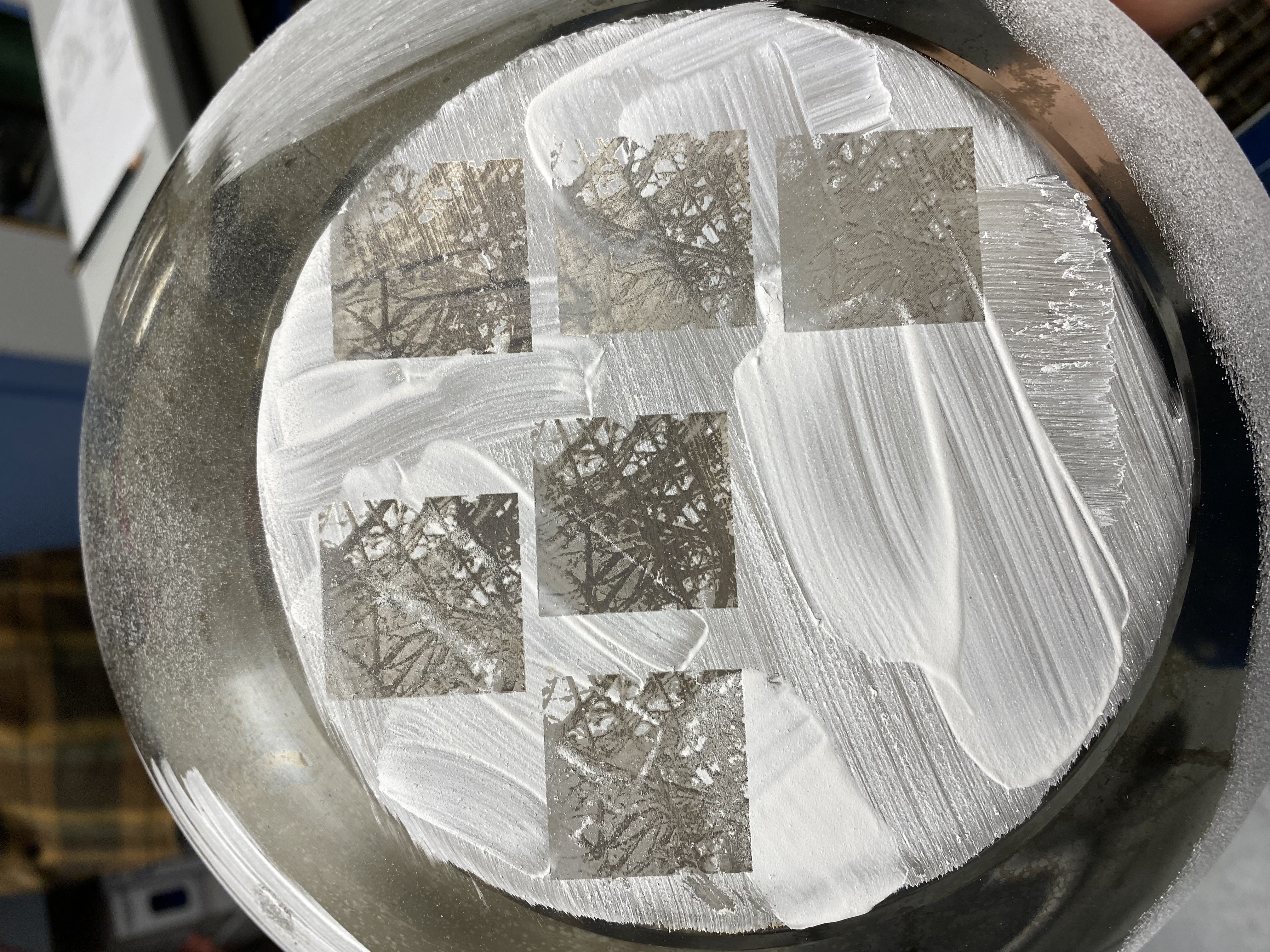

Another thread to pursue that I am excited about: picking up on mirrors, and the literal and metaphorical power of reflection.
These initial tests of the laser on dollar store stainless steel were encouraging, for sure. Finicky process, for sure, and lots and LOTS of variables to be worked through, but in the end - and after only a few hours - I think we got somewhere.
These are before and after shots, using plaster diluted with alcohol for the etch. The image is a crop from a photo of the caragana trees in the installation - lot's of detail in it, which I wanted to examine right form the outset, to see what I'd be able to get.
The goal here will be mirror-finished stainless steel panels, etched with images from my own family history, (my Dad's family homesteaded) and images of the people who homesteaded the land where the installation is. So that the viewer has to see themselves through the filter of settlement and colonialism. Our selves have to be read through that filter: we are inside it ALL the time, and it impacts all of us (but very differently depending on the privilege we hold within that system, of course).
The 'mirrors' will be virtually indestructible - well, much less prone to damage than glass, anyway! - so that there's something inherently unavoidable about them. You can't break the mirror and make the image go away: the solidity and durability of the steel sheet insists that you see yourself through (and within, another layer in, another generation of) settler colonialism, and recognize it, in yourself.
On a practical level, the material is less dangerous to place in a gallery or in the installation because it can't break and cut someone ... and it's basically impervious to the elements, which excites me: I want to see them installed in the trees, so you come upon them in the space ... and see it and yourself reflected there.

A LAST LOOK AFTER THE FINAL OPEN STUDIO>
It's definitely been good to take a few days at a slower pace ... I also recognize I really haven't had a choice in the matter in many ways.
Tired, and my head is SO full - it's going to take time and quiet to process all the ideas & feedback from the last 4 weeks - but overall I'm feeling good about where I got to in this Intensive. Starting to feel a little more confident in my choices - I've always worked somewhat intuitively, and I don't think that will ever change - but I am beginning to understand the relationship between those 'hunches' and the bigger theoretical concerns that I am wrestling with on an ongoing basis. That feels good - something more solid under my feet.
I've been getting things done though - lots of stuff for the house purchase coming together, so there's all of that - but also more research, and developing a reading list for the next few months, that I'm really excited to dig into!
A list of artwork to follow up on and look at too - looking forward to doing that as well.
And in the mean time - a wee break, punctuated by 2 very saucy crows today. How lovely!! My favourite species - Corvids - their intelligence and sass is really so wonderful. Made my day.
Things that keep coming up for me, not just in this particular creation/research project:
- Borders and Limits - defining space and the limits of access/permissions
- these can be both viscerally/physically experienced, and embody an abstract sort of vastness - a largeness well beyond the self. A fence that divides one quarter-section from another is human-scaled, sharp with barbed-wire restriction. The results of transgression can be traced on the body, in the skin. But then look down that line of fence posts ... and it becomes something else. That row - however straight or crooked - extends in space, on and on beyond the body wanting to cross it, out to the horizon. Another immensity, where earth and sky meet, but only in a distant illusion of the eye's making of the earth's roundedness. Those fences go on and on - are built, get damaged, posts break, wire gets tangled (or cut - another transgression) - and then they are replaced, repeated. Reiterating their capacity to contain and continue well beyond one person's being or will. They embody a system of control, far larger than any of us as individuals ... which is maybe why one person can slip between the wires, but hundreds get stopped, and a wall gets built instead.
- Maps - as a tool for exercising power and control, as a means of colonizing space and claiming land (and people)
- related to borders, obviously, but they hold a different kind of psychological space: maps are about KNOWING, about naming and identifying and establishing a perspective on a place. It's a limited view, to be sure, but the attempt is to take something of the place into oneself through the act of drawing the map. Seeing (hmm - maybe just 'looking' since seeing implies a deeper recognition) becomes drawing becomes a map. Maps are symbol-things that can be physically manipulated, in the hands of both the colonizer and the colonized. They can be torn, burned, re-drawn, erased. There's an odd disjuncture in scale too: what is described visually on a map that can be held in one's hands may be a vast expanse of land and sea. This is a compartmentalization of space, to make it somehow more manageable, to make it easier to "own;" this too is inherent in the process of mapping. The human psychological need (in the Western thought tradition) to name, claim, identify, compartmentalize, classify, define, contain... own. It's all there in maps.
Maybe that's why they hold such fascination for me; I don't understand the way maps think, not really. I understand it in an intellectual sense, but I can't understand the desire they express. It is overwhelming and destructive, to me at least. They are less wayfinding tools than they like to pretend they are (or that is conventionally understood in their utility).
I'd forgotten bout this little time lapse - shot at Thanksgiving a few years ago. Harvest.
Another kind of insistence on the
utility of all things, time included.
Another kind of compartmentalization and assignment of value.
How many more?
How many hundreds or thousands more will they find, and how long will it take for each of us to truly comprehend the loss - to carry the weight of it on all of our shoulders, to face the responsibility, so that the weight their families have borne can be a bit lighter going forward.
I haven't been able to write about this until now.
Wrestling with the anger, the grief, the shame. Knowing that I had no hand in it, directly, but I come from a place - was born and raised in, and taught to be proud of - a place that embodies the cruelty, the still very real violence being enacted upon the bodies of Indigenous people. In Edmonton, there is a train station and a neighbourhood , and a school in that neighbourhood, named after Bishop Grandin ... at least the mural in the station is now covered, the name of the station scheduled to be changed.
There's Oliver neighbourhood too - for Frank Oliver, one of the architects of the Residential School system in Canada. There's been requests from the more progressive members of that community to change the name ... maybe now they will be heard. OR maybe not.
A sacred site in the river valley was partly covered by a freeway. At least (a few decades later) there is now a park and interpretive signage acknowledging the site. But the asphalt and the cars remain, whizzing by every day.
Mill Woods, a neighbourhood of newcomers ( who happen to be mostly people of colour), was built on part of the land denied to the Papaschase Band... a double-whammy implicating people who have no prior knowledge of the history of the place they now call home - and for whom racial and religiously motivated violence forms an increasingly real and present danger.
And it goes on. I was reading today, doing some research and gathering resources to help me think through the legacy of Settler Colonialism, how to best to combine theory & practice to express some of this in the work I want to make, and how I want to write about it. And I came across Kara Granzow's book, Invested Indifference: how violence persists in settler colonial society (UBC Press 2020). In it, she presents an argument that correlates the Settler Colonial project explicitly with the violence inflicted upon Indigenous bodies - overwhelmingly those of women and girls - in Edmonton, in the city of my birth.
She notes in the closing of the book:
In the preceding chapters, I have examined the violence enacted through targeted and specific aggressions against particular people, or rendered bodies, in particular places and
through the sometimes impalpable and nearly impossible to study damages of historical objectification and erasure. Read through each other, these contact zones suggest the endured heritage and the promised future of the incidents of disappearance and violence in Edmonton. Positioned as transcending an immediate time and place, these contact zones expose repetitions that occur in temporally separated moments and in spatially
separated (yet always) local places to haunt and indeed (pre)occupy the city and those who live there. When positioned in relation to each other, these contact zones reveal that what has been called “societal indifference” to violence looks more like various small (sometimes big) and specifically dehumanizing practices that might be considered to effect not a passive
indifference but an active and affective authorization of violence on a larger social scale. Acts of violence are bolstered by the social affect embedded in particular practices (J. Butler 2009, 50), including in the claim itself of an expectation of indifference, which not only names but also, I think, prepares and instructs. The notion of societal indifference toward some deaths references the production of both citizen and noncitizen subjects – the former of whom are considered human and internal to the settler colonial nation and the latter of whom are considered exogenous or even threatening to the nation and are thus dehumanized.
(pp. 191 - 192)
And she's right.
At first I didn't see it at all - was too young to understand or recognize it. Then as a teenager, I saw it, and didn't think anything of it, having been fed the lie of neoliberal meritocracy coupled with a good dose of the Anglican version of the Protestant Work Ethic ... so what I understood, then, was that hard work solved EVERYthing; only those who were "lazy" or "corrupt" or "bad" found themselves in trouble with the law, or homeless, or sick, or using drugs and alcohol, or unable to get a good job and keep a nice place.
Leaving home at 17, I discovered a very different truth, and my real education began.
And I'm still learning.
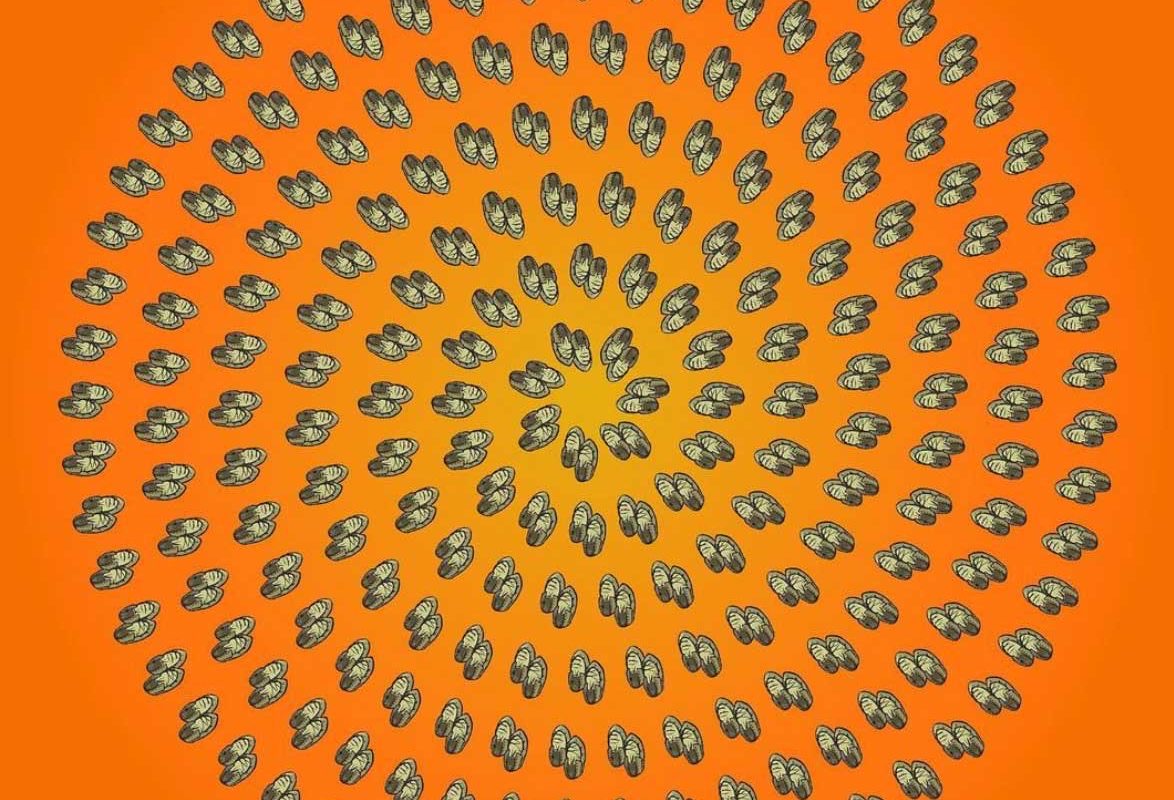
A photo from a history of the area around Warspite, AB - which is a town just north of the homestead where I've worked for the last 10 years.
These are kids from the "Lopstick" School - many of them Métis; the school operated for 5 years in the Lobstick Settlement, a series of lots held by Métis families from about 1865. The school only operated there for 5 years, and was then moved north of Lobstick, to serve the ever-increasing numbers of white settlers to the area. I don't know if the Métis kids continued their education at the new school. I hope so; I'm trying to find out.
Learning to Die: Wisdom in the Age of Climate Crisis. Robert Bringhurst & Jan Zwicky. 2018.
Notes I have written to myself in the heat of discussions - art and ideas to look up ... bread crumbs to pursue ... more thinking to do.
WOW> The things you come across when you go down research rabbit-holes!
The most AMAZING propaganda for the settlement of the western provinces! And this stuff was distributed all over Europe to "populate" the land that was to become Alberta, Saskatchewan, Manitoba ... (not like there weren't Indigenous and Métis people there already - but, hey, this is Settler Colonial rhetoric we are talking about!
YUP - "free land" ... fill up that space with European immigrant-farmers, so that they will clear the land and help establish the Dominion's claim to the territory. Immigrants and trains. Two things that helped secure the claiming of all that land for the country that would become Canada as we know it now.
This one was for the English Country Gentlemen ...
Homes for millions ... yes, but such a price to be paid. The mind boggling amount of work it took to clear the land, build shelter, plant and harvest.
Just to survive.
And how that was packaged and sold to people who wanted to leave Europe for various reasons.
They were pawns in the game of dominion building - granted, pawns with more opportunity and standing than those with darker skin - but they were pawns.
And what that meant - the knock-on effect - of this political and politicized process ... this legacy of disenfranchisement, displacement, erasure ... this is the benign part of it all which is truly horrific when one stops to think about it, even for a second.
Well, that was an interesting digression - connected to where I was going, to be sure - but a "side quest" as Kellyann would call it. The place my brain keeps coming back - and where I need to focus for a bit - is the Dominion Land Survey. How that mapping and measuring project carved up land and space: consumed it in a way. Laying claim to acre after acre: absorbing the land's ability to provide vast amounts of raw materials and resources, defining it's capacity to yield crops for profit ... and all the while, the end-game of keeping US expansionist interests at bay was in the mix too.
Such a constellation of political and social circumstances, shaping this place and its history.
But what's even more troubling is what I am having difficulty finding - what the history "isn't" versus what it is. Case in point: I can find loads of maps from the DLS, different iterations of mapping the land that includes what is now my dear friends' little farm. But only by chance did I discover the existence of Reserve lands close by - or rather, that a Reserve had existed at one time very close by.
A blip in history - there and gone - IR 126 (Washatenow/Hollow Hills Creek) shows up on early maps of the area, and then is simply gone. Inquiries to various archives have yielded more threads in the story: the actual signature page from the Reserve's "surrender" back to the government. The mapping of the "Cache Lake Addition" (IR 125A), designated as a replacement to the surrendered land - also signified the removal and erasure of Chief Muskegwatic's tribe from the mapped record of who belonged where.
Of who had the right to say they had the right to be there, in that place.
It took me weeks to start piecing this all together. And I still don't have the dates straight in my head. And I came across this by chance.
I was corresponding with an archivist at the University of Calgary about some of the historical maps he'd helped me find, and about the surrender of the Reserve and so on - I was hoping to find an image of the Chief or a group photo of the signing of the documents of surrender - or something ... there isn't any visual record. Documents (scant), maps (buried in archives) ... . I had also asked about "Road Allowance People" - the Métis who were dispossessed of their land, and wound up essentially squatting on the Crown road allowances near where their traditional homes were. They had no status with the government; they paid no taxes, true - but that also meant their kids weren't educated. They built shacks out of recycled scrap from wherever they could find it. Shanty towns on the side of the road.
SO I asked about these people - there are images of Road Allowance People and communities in Saskatchewan and Manitoba that I've come across - and mention in several places of Road Allowance People in Alberta ... but no images. The archivist had never heard the term; didn't know anything about these folks; didn't turn up any images from Alberta.
I've since found a bit of information; a few leads to follow. But they are tenuous, and where they will go and what I will get in the end remains to be seen. What strikes me most at this point is how hard I've had to look - how many different leads I've had to follow just to get a little more information, another potential source.
That alone speaks volumes.
I have just now starting digging into the glorious book, Towards and Encyclopedia of Local Knowledge, excerpts from Chapters I & II ... I could spend a great deal of time in this world. Pam Hall has long been a favourite artist of mine, and this lovely volume just reaffirms this for me.
She says so many things that ring deeply true for me - and quite eloquently, at that. In this moment in my own work, I see in her writing a confirmation of my own intuitive understanding of embodied experience, of the deep learning and thinking that comes from making. It is profoundly active, connects intellect and spirit to physical being in ways that defy categorization.
She says in the introduction, "... it is bodies that know.... knowledge emerges in bodies learning to do and know through observation, mimicry, practice, experimentation, and experience. The Encyclopedia ... thus begins with bodies in relation to and engagement within their worlds. Bodies in place." p 16.
And that's the thing of it, really: bodies in place. Body as context, and within context - the physicality of coming into knowing - and coming into being through sensory exploration.
I think that maybe that's why I have never been wholly satisfied with an exploration unless I have come at it through multiple media - that engagement with as many of the senses as possible. Having my hands in the process, my body as integral to the making in a variety of ways.
This is the appeal of video and audio work for me: it's a way to approach the immediacy of experience, the specificity of a given moment - at once particular and common enough to be able to be readily shared. Shooting is often a process akin to walking meditation - I let me eyes and ears draw me to the particular of a place, the being-in-the-moment of it allows me to quiet the mind, stop over-thinking, allow the senses to lead the teaching in a much more direct way. The thinking can come after, in the editing - that's where I learn about what I was actually seeing (which can be different from the experience of shooting). But even in editing, what I am working to achieve is still deeply & closely connected to that initial experience of letting go and letting sound and vision carry me. I don't pretend that it can be a facsimile of what I experienced; it's a translation, I think ...
Likewise, printmaking functions as a physical learning (and re-learning) of the thing I am printing. My hands offer a sort of double-vision: when I'm carving a lino block, my hands 'see' the curves, the lines become pathways for the body to investigate relationships between things, to coax forms and patterns to have conversations. That there's physical demands made to create those blocks is part of it too - understanding where the fatigue sits, what muscles are getting sore, how I am standing: one one level I am engaged in abstract considerations of measurement and line and patience and control, while the meaty animalness of my body and its limits teaches me about those relationships and ideas in a different way. They are felt: they hold tension and weight and strength.
Hmm ... need to think on this more. The sculpture, especially - that's going to take more thought to properly work through in words. (the irony's not lost on me here, that the reason I make art instead of only writing is that there are many times when the words fail me - or more correctly, I fail to find the words I need - to communicate what I want to).
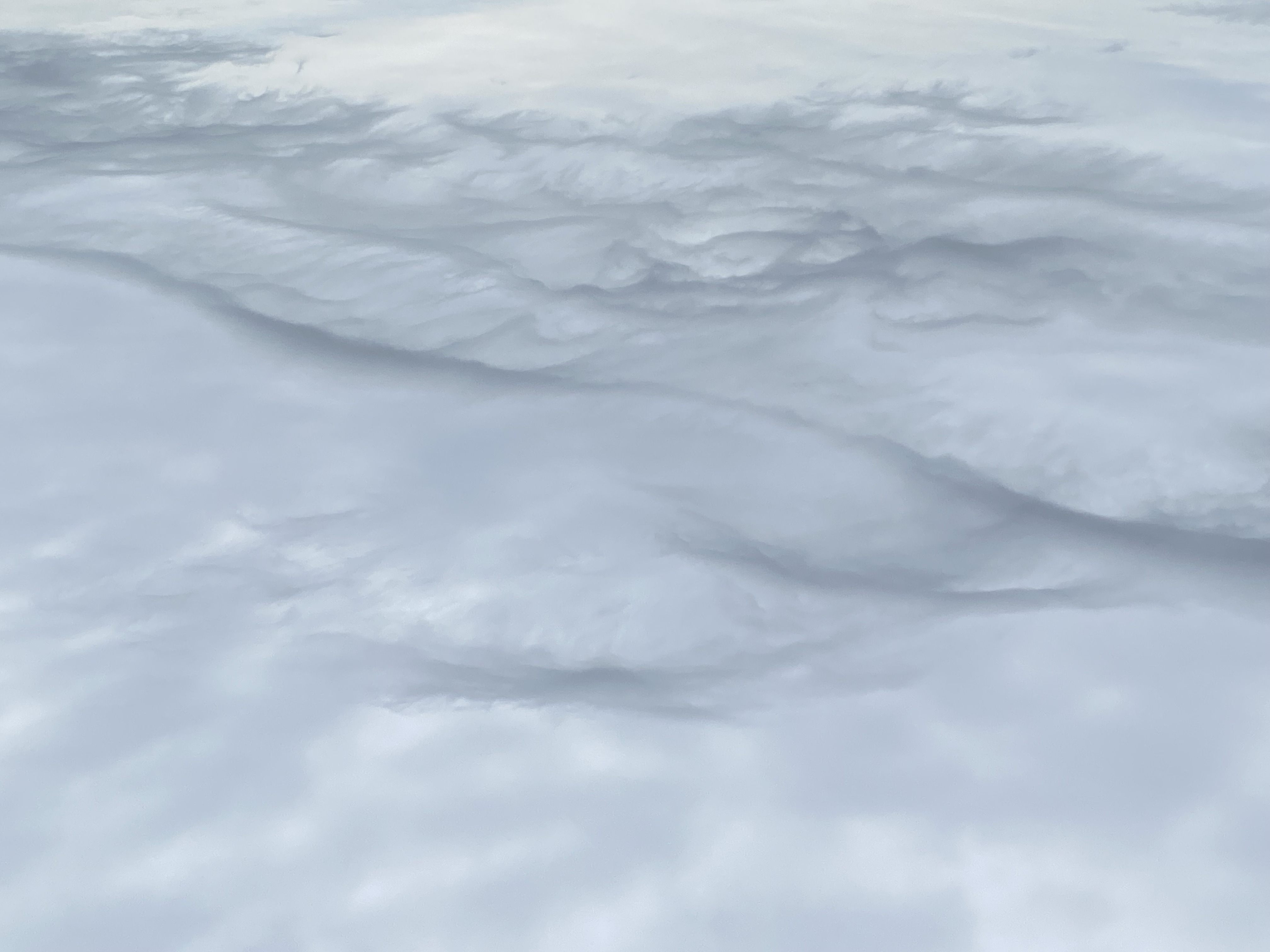
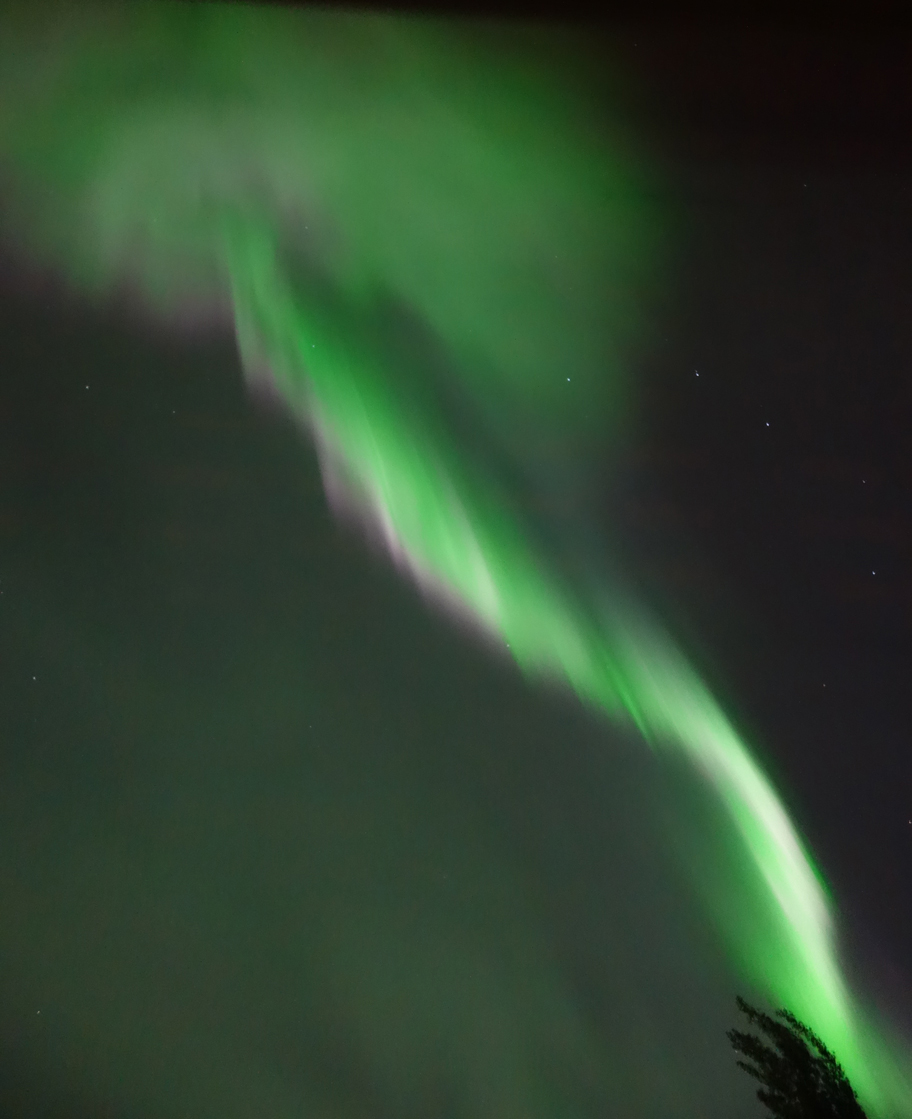
I came across this on my phone - from 2018, I think - the most spectacular display of the Aurora I'd ever seen. Stayed up until 3 in the morning watching and shooting.
Still doesn't seem real.
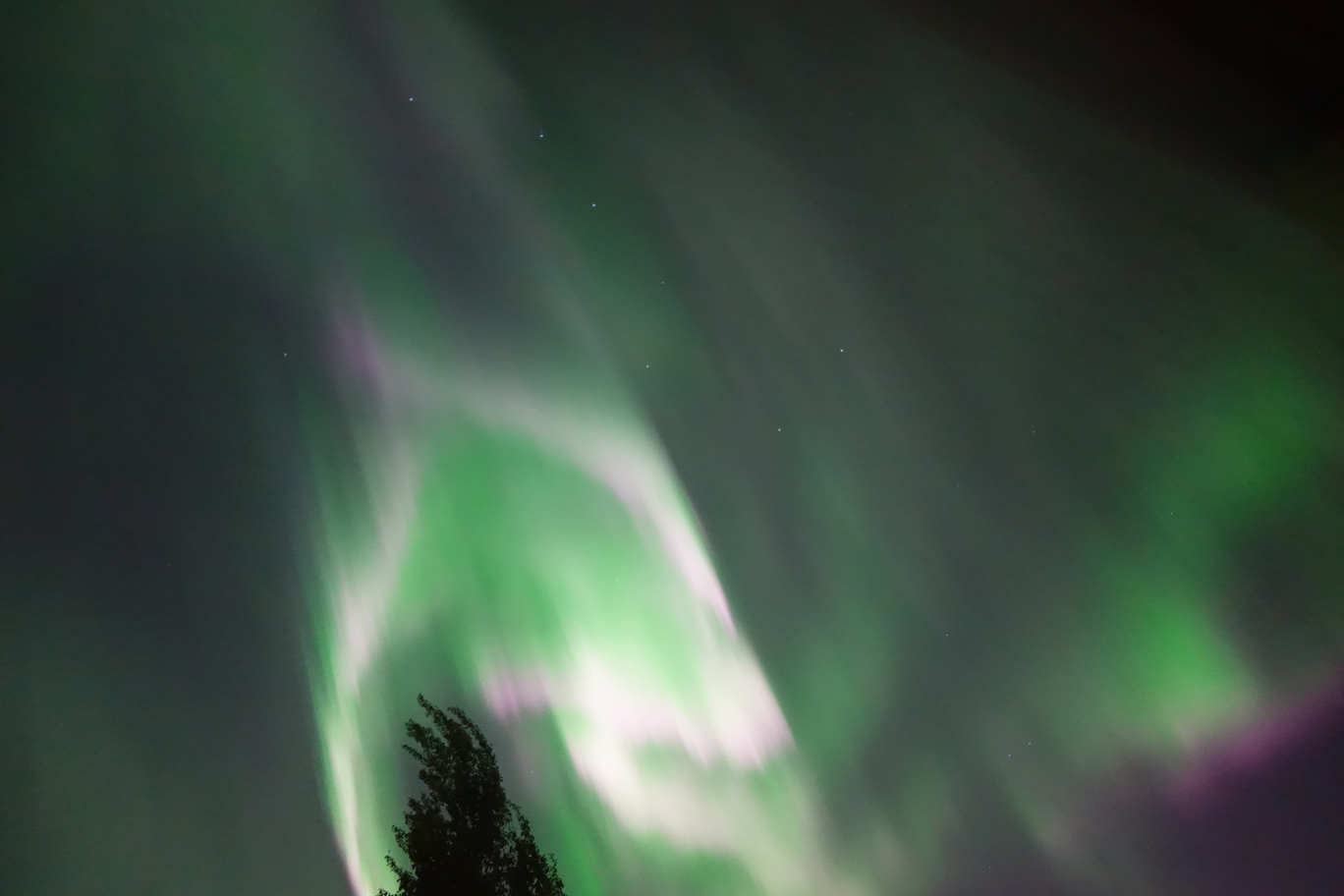

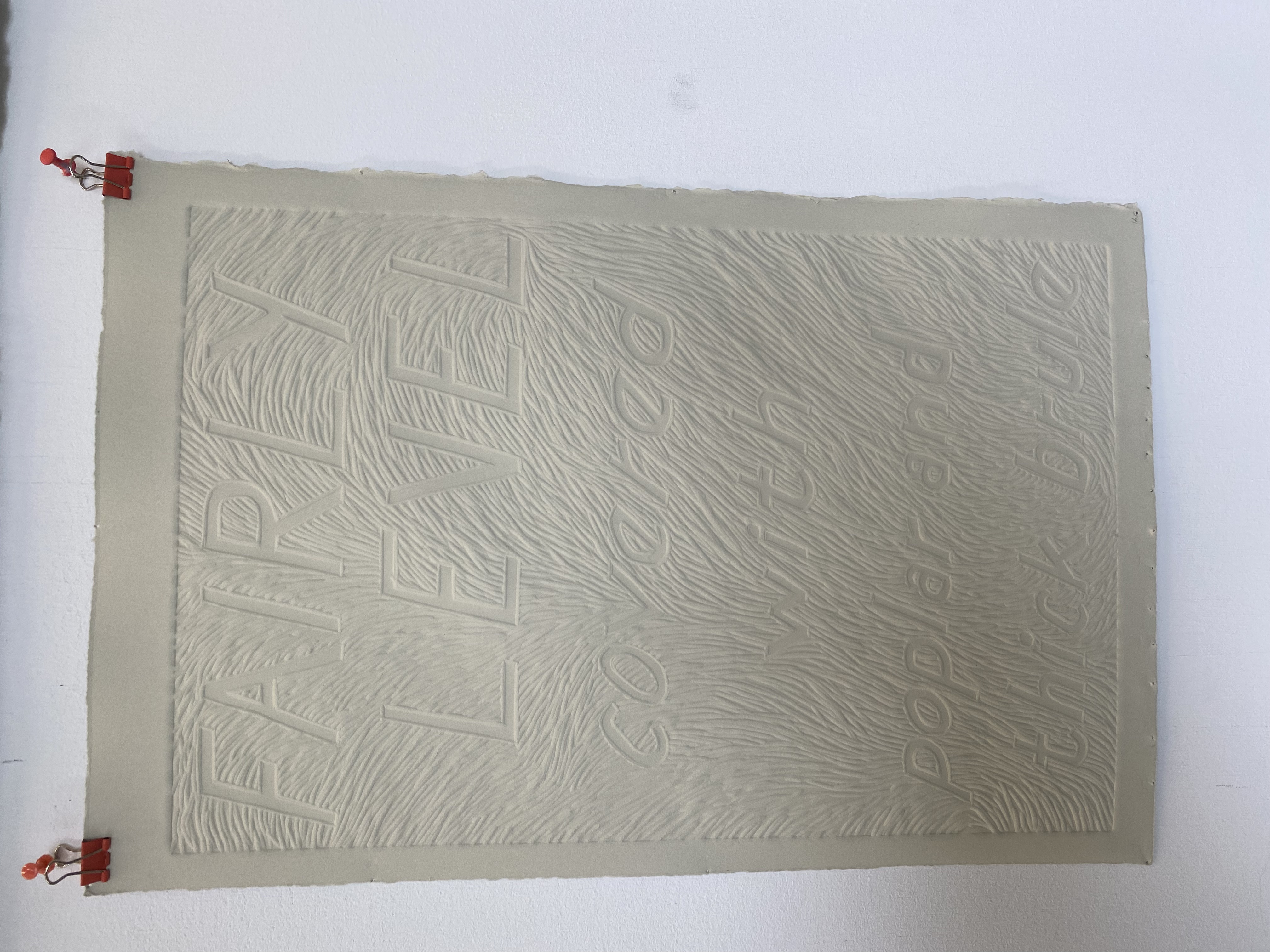
A mirror, and its reflection. I am quite pleased with how this block turned out; I like the texture of the marks - like animal hair, or wind-blown grass.
It's going to be good to dig into the next set of maps I have waiting for me; there's surveyor's notebooks to look through too, and they contain yet more commentary on the land and its 'potential': the raw materials just waiting to be harvested, used, civilized.
I'm really happy I was able to get this second block done before I left - the more I carve these, the more I learn about what I am looking for in the background marks, and how the text conveys meaning through scale and angle in relation to the background marks. I've tried to create the sense that the letters have been pressed into an organic surface: that they have physical weight in addition to the weight of their meaning as a "reading" of the land and its value. More of these to come, for sure.
I also took this last opportunity to be in the printshop to play a bit with borders for these - the prints evoke completely different things, depending on how much white space I leave surrounding them. The one above reads like a road sign in real life; the scale and the slim frame of blank paper are right. It's an interesting think to consider: what would these phrases look like, painted as road signs and put up along the Township and Range Roads in the area of the homestead? They'd morph into another thing, speak to a different kind of utility ... would they mark places, serve as beacons or guideposts to discovering what they themselves catalogue? Would that subvert the original goal of the map maker's comments? Shift the phrases from declarations of potential use-value to ... what? Declarations of presence? The stubbornness it takes to survive and stay true to one's being?
I don't actually know.
I also don't actually know if this is even worth thinking about in any practical way - but it is an interesting chain of thoughts to follow as part of investigating ideas in this jumbled brain of mine.
Measurement is a weird thing.
I find the way on which measurement has evolved in western thought quite interesting: the shift away from the body as part of a process of investing those measurements and their systems with (what?) authority? Some sense of irrefutable truth I guess: the truth of machine accuracy, rather than human scale. Scientific/objective distance.
I can't help but see a metaphorical or symbolic importance o the unit of measurement used for some of old maps I have from the U of C Archives ...
measured in "Chains to the inch" ... how fitting for a Colonial approach to land.
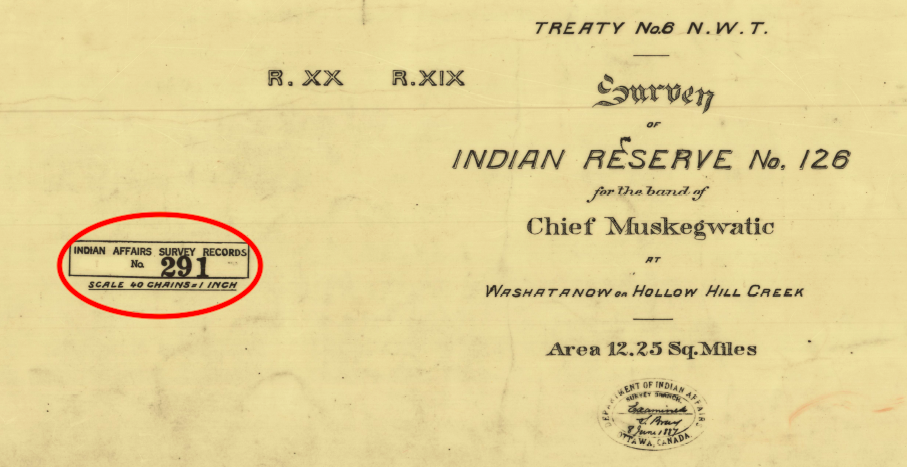
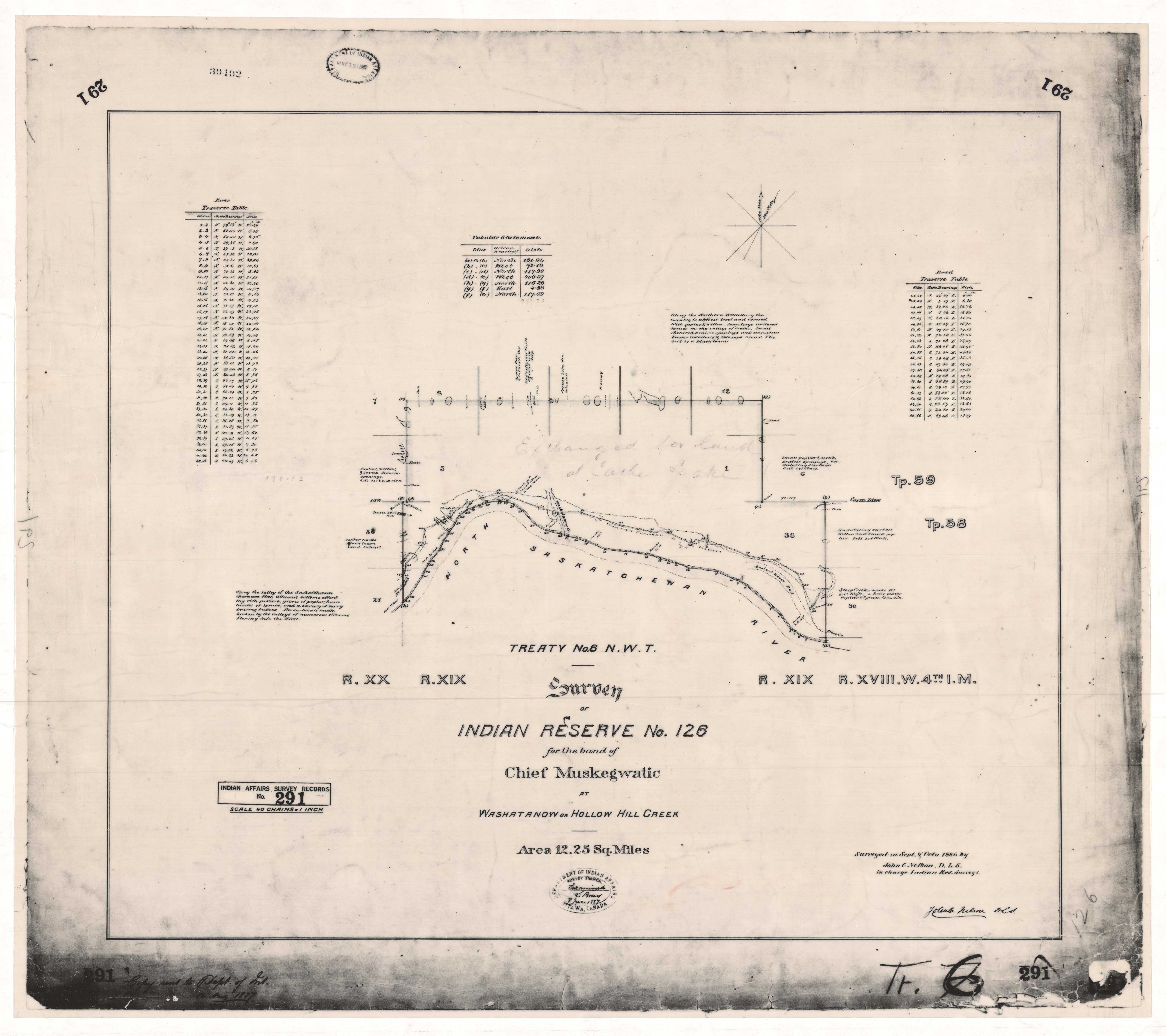
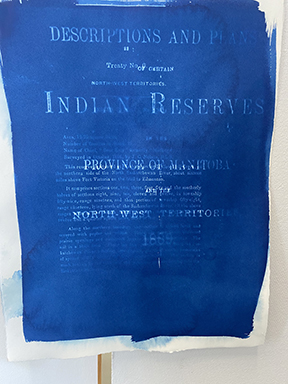

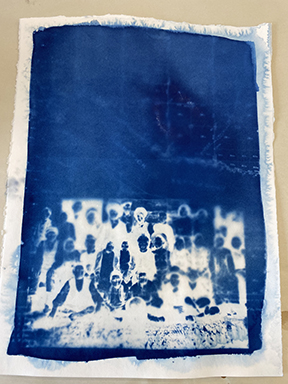
An interesting experiment, these three.
Deliberately badly exposed, in less than ideal conditions, and with variations in contact between the paper and the film positive.
I wanted them to feel indistinct, to capture some sense that you were looking through something dense to see what was behind ... or that clarity was just out of reach.
I think these might work as background images; I don't think they are strong enough to stand on their own ... maybe the middle one (I LOVE the graphic quality of the plow lines in the field!) ... but really, they all need something else. OR just to be filed in the 'interesting but not especially productive file.' I will see in time.
These are the last prints I made before packing up the studio.
Somehow, that feels right; to be sitting at the end of this incredible time with images that encapsulate so much of what I've been thinking about. The reserves, the callous and self-serving way that the government saw fit to deal with Indigenous and Métis people when the West was being "settled" ... how much this is still the case.
And how many of these stories - these histories of relationships between people and land - have been distorted or virtually erased ... the cultural (heroic/nostalgic) re-presentations of this time and this process, that paints it as a success story - for everyone worth mentioning.
IDEAS.
So. MANY. Ideas.
I came into the Intensive feeling fairly secure in the thought that video would play an integral role in what I wanted to present as part of my graduating exhibition ... and then the embossing and the mirrors happened!!
Which is amazing - I am so happy with where I got to in this short time ... but it did raise a set of new questions, too.
I was really beginning to wonder what role, if any, the video would have - how that way of seeing could be connected to weight and reflection.
I was definitely understanding video as a vehicle for bringing people to a place they would likely never see in person ... a way of transposing or translating that place to this place, and also a way to exploit the potential for video to be a more immersive experience, to provide an invitation to step out (or beyond) the limits of the white cube for a bit, and engage imaginatively with an elsewhere.
And on a (somewhat related) note, the question of what role the caragana could play (if any) in a direct way has been bugging me ... because if hypothetically, I wasn't using video to convey something of the space and the plants (the whole green world that it is), and bringing live plants into the gallery is not something I can do in good conscience (both in terms of gallery protocols, and also the fact that caragana is a non-native, invasive species! If I had live plants in the gallery, I would have to destroy them after the show so there would be no possibility of them spreading in NL ... and I am not going to kill plants that can't help how they are, and that didn't ask to be brought to this country in the first place! These beings deserve respect as well). So what would that leave me with - I wanted something connecting the plant, the ink, the settler homesteading, and that experience of place ...
And then I also kept on coming back to Andrew's question: where am I in the work??
And THEN: a really fruitful discussion with D'Arcy! I came away SO excited by where it all went, and how the possibilities opened up, in just two hours!
The "TO PURSUE" list:
- caragana seeds as a source of starch for thickening ink for lino cut
- maybe papermaking? as part of the book work I want to make?
- acts of care and stewardship - how those actions on the farm can be seen as decolonizing the space ... that is important to acknowledge
- the woods - and removing the invasive /non-native plants there - ESP the caragana (which can overrun the place and kill everything else) ... SO: those caragana that we remove can be used for materials for the work (bark, seeds, leaves) ... and ALSO: removing those plants can be documented on video as a performance!
!!! YES !!!
That feels so right on so many levels: it brings together ideas of care, emotional effort (one aspect of weight), farm labour ... and extends the metaphor inherent in the caragana itself: it is a fast-spreading, incredibly hardy, invasive plant ... brought by settlers ... just like the settlers themselves, myself included.
Removing those plants from the woods can embody a first effort at refuting that legacy.
That's where I am, in the work.
Institutional/ political maps differ so much from the maps we hold in our hearts and memories.
Even if they are of the same places.
How can that be used to SUBVERT the political intent (the colonizing impulse)>?
This is a sad picture.
I am going to miss this place.
But I am so grateful that I got to spend time here.
This lot got sent off in the post.
The leaving has begun. In earnest.
Most of the stuff in the chalet is packed too, as of tonight.
Stripping it down to essentials for the next few days, finalizing plans for storing things and for travel.
A few days away from a new adventure.
what is ‘behind’ you
that you can’t
see
except with the help of a
mirror?
PART THE THIRD
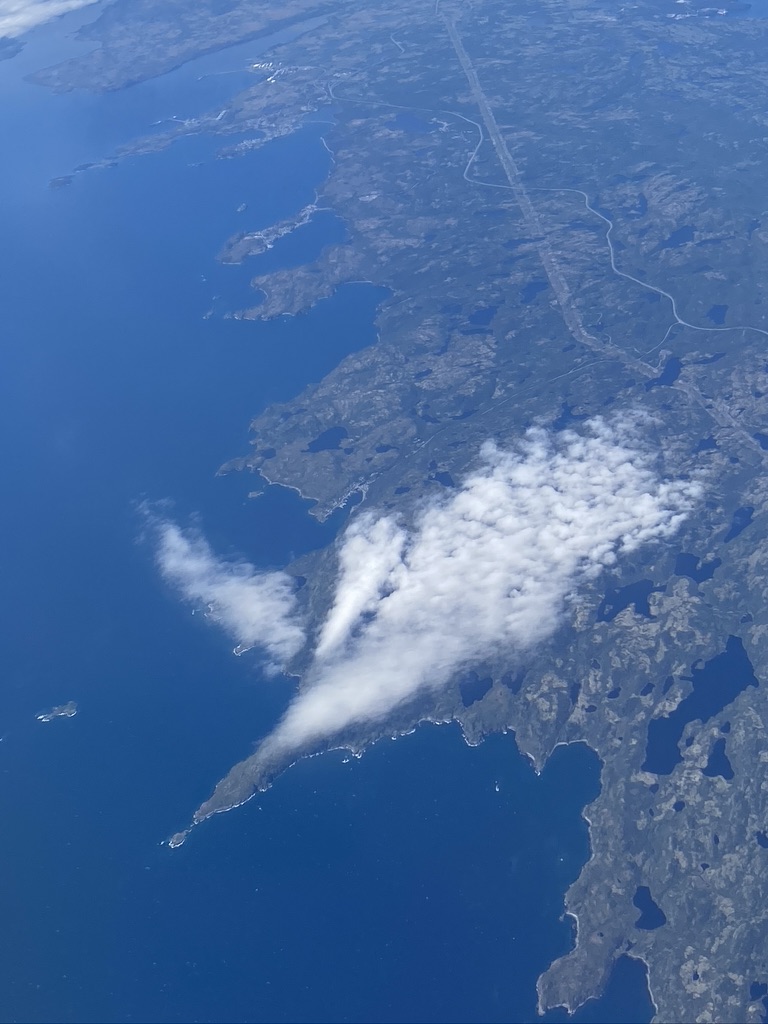
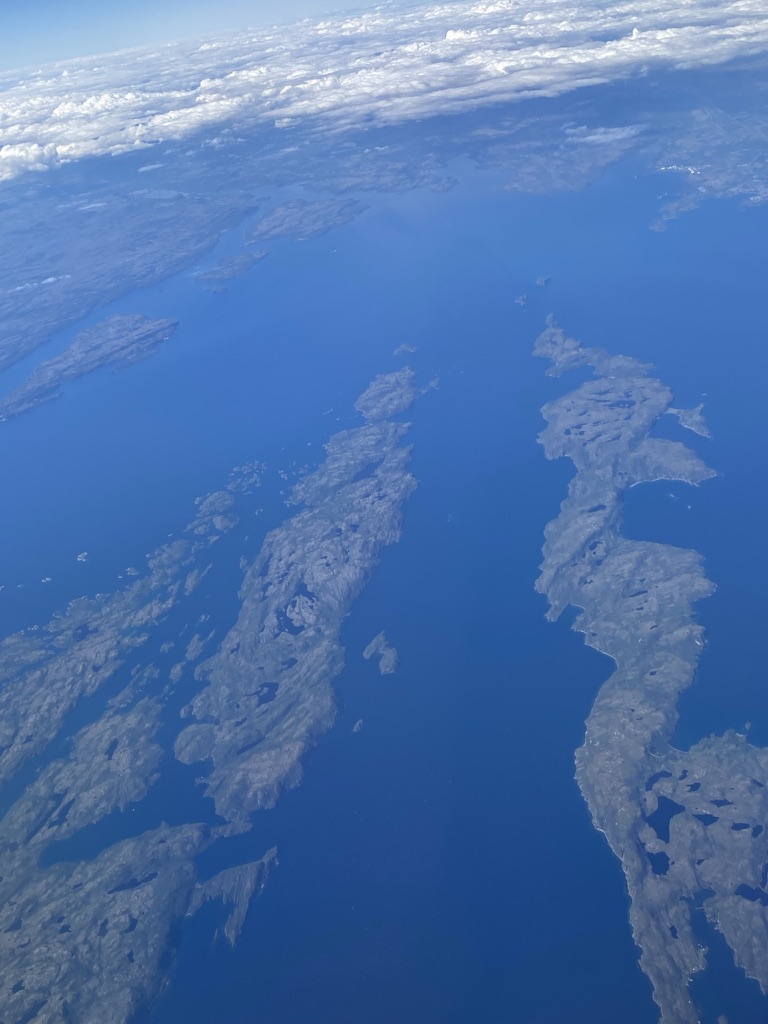
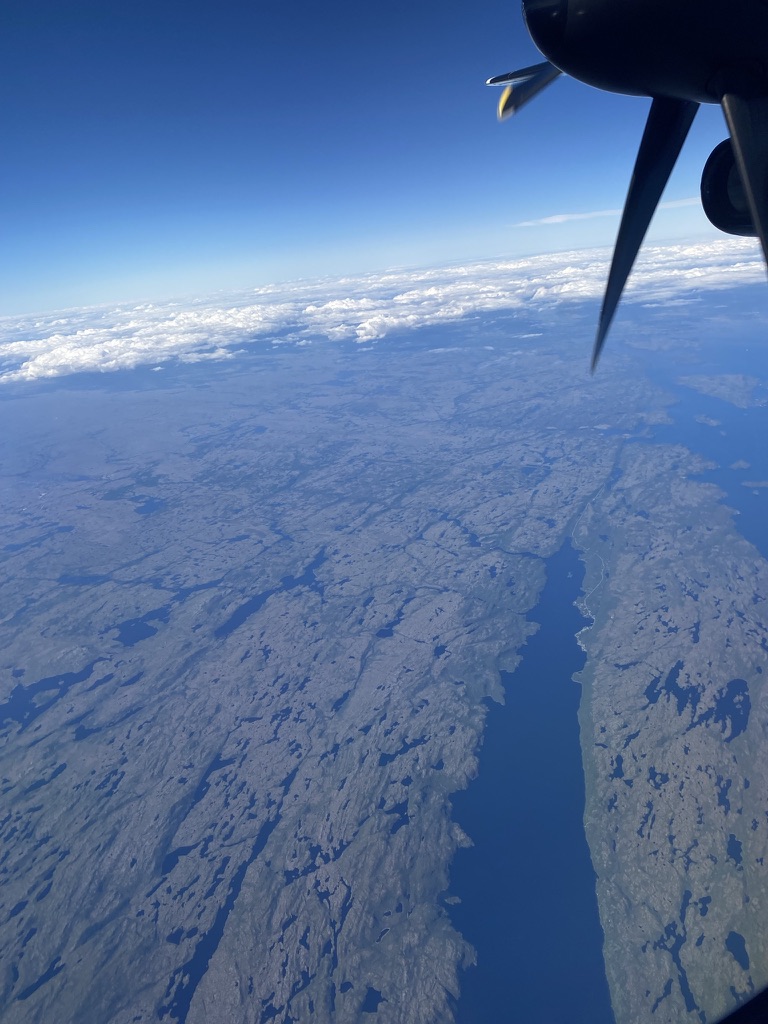
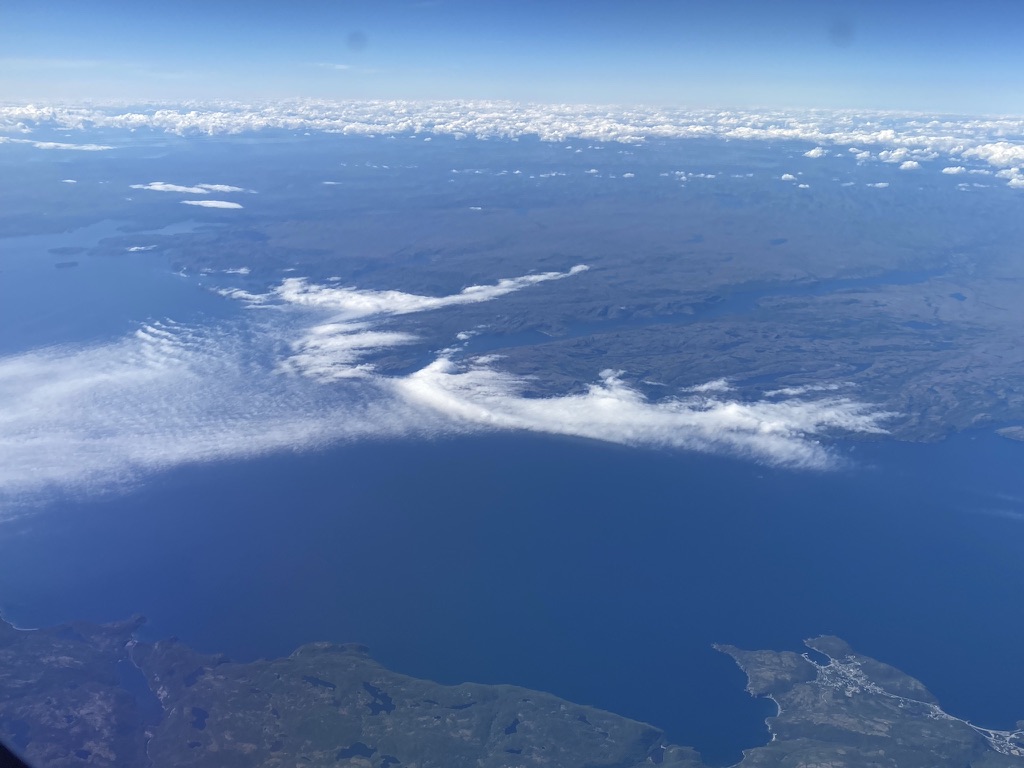
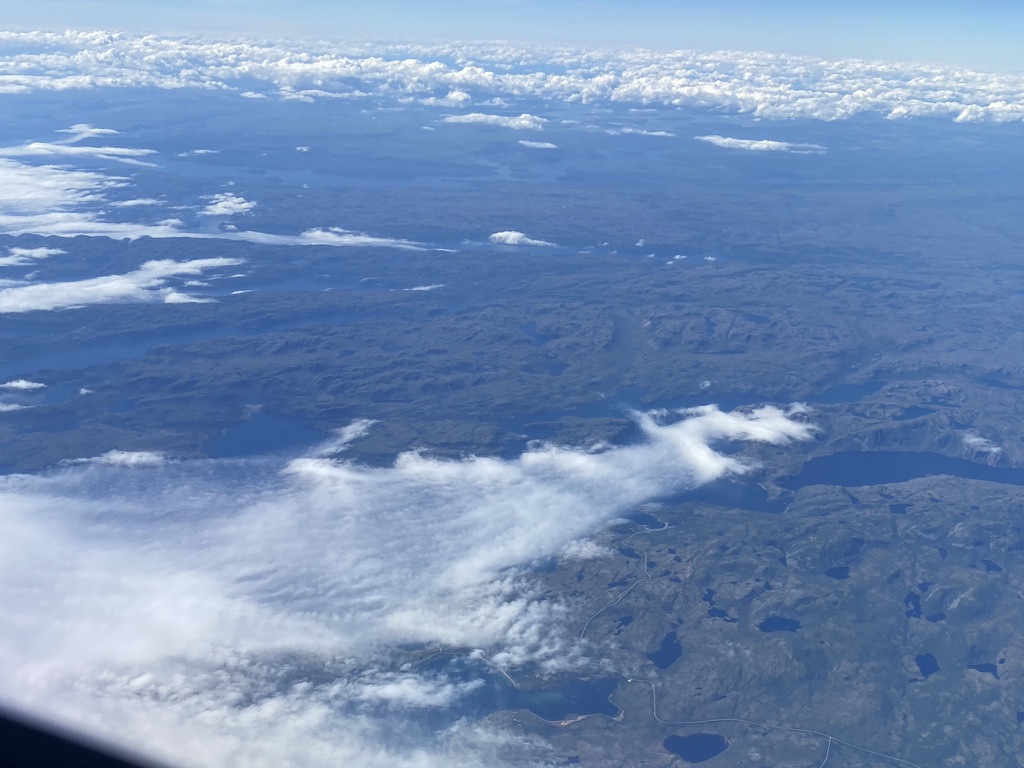
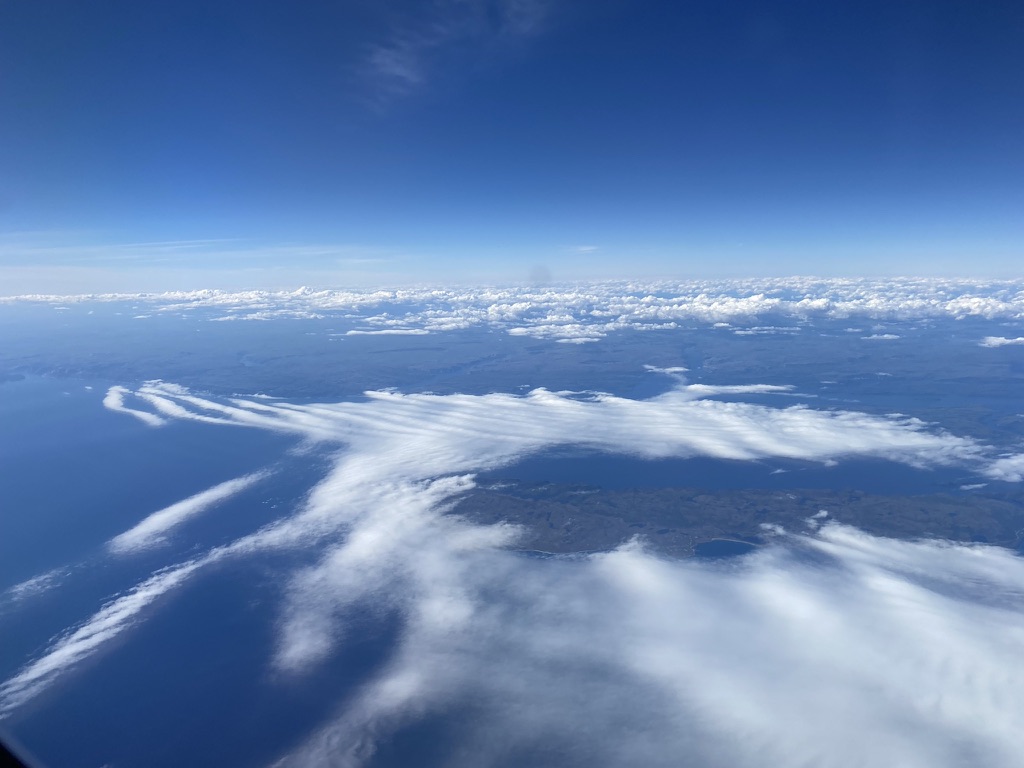
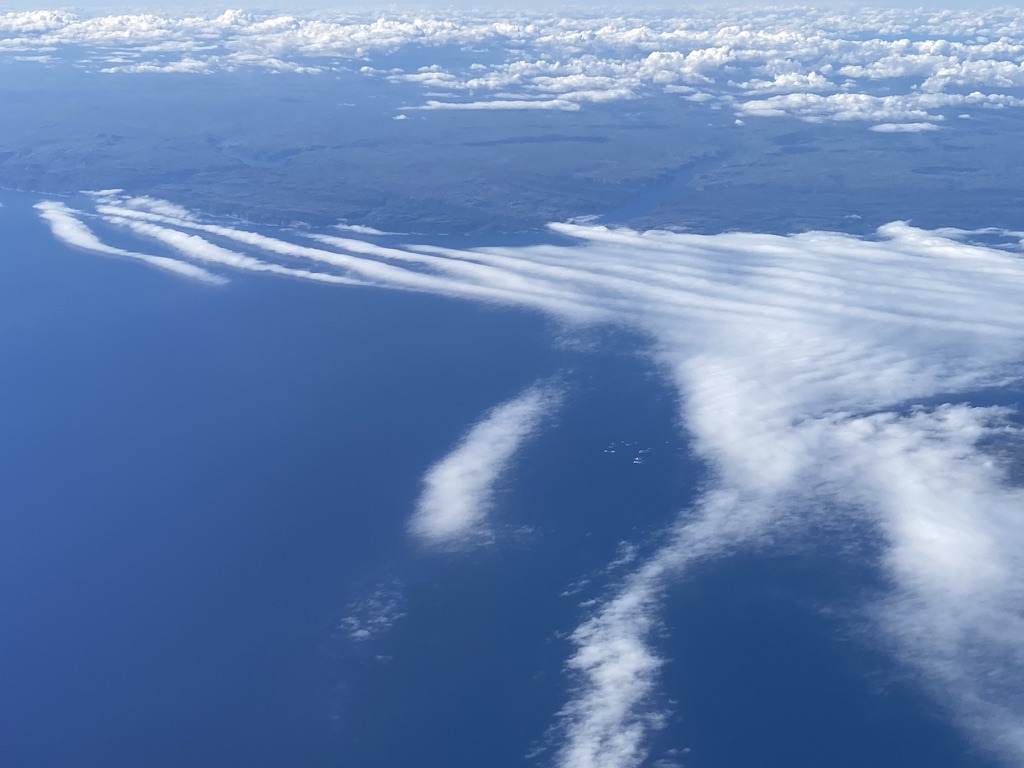
Summer Solstice 2021. Flying.
This time last year, I was on the land, at the farm, working in the trees and looking up at the sky.
This year I am in the sky looking down.
Seeing a part of this vast place that I have flown over maybe twice - still, more often than many have had the good fortune to experience.
This day brought water clouds. Obviously, made from water vapour as all clouds are. But there are days when the clouds themselves reflect the shapes of waves, of ripples in a tide pool, of ocean meeting shore.
Reflections of their intrinsic being in the world: made of water, making water forms no matter where they are. And reflecting the water below them as well. The movement of the salt water below, the meeting of coast and ocean.
I was so struck by how the cloud hugs the land in these images. I've not seen shapes quite like this anywhere else so far. There's a sensuality to the wrapping of land by cloud here - perhaps a dangerous sort of caress - hiding the potential for scouring rain, or biting wind; this change of heart that can change the lives of those encountering it for ever.
I'm enough of a "folkie" that I've absorbed the complicated relationship of people to the weather and to the sea here.
The East Coast - The Maritimes and Newfoundland - have begun to teach me their lessons about unforgiving moments in the world. This is different than the sometimes harsh ways of the Prairie. There's a starkness there that you cannot ever confuse with the occasionally deceptive weather and water here. The Prairies are plainer speaking in some respects: unrelenting in their insistence that things will happen and they will be hard: a crushing hail, a window-rattling thunderstorm and downpour, and searing heat, cold that catches in the lungs in viscious dryness. But these things, we are told, are equally changeable and temporary. The storm passes, the sun comes again - sometimes, in a matter of minutes.
Out here, it's different. There's an insistence, a relentlessness, intermixed with fickle and deadly changeability.
But today, the clouds ripple and wrap themselves around the headlands, soft lovers offering something approaching caresses.
It is the land that holds fast, allows the draping and wrapping, the closeness.
Back in Nova Scotia. Long day's flight, but it's good to be here again - and after many machinations and adjustments and waiting for approvals, it all worked out in the end.
Not necessarily sure of the wisdom of flying through St John's to avoid Pearson. The stress of not knowing FOR SURE if my bags would make it to St John's - and PAL's insistence (despite $145 in baggage fees (!) that they couldn't guarantee their arrival) was a tough thing to swallow. SO was knowing that if the bags made it on a later flight, they weren't going to do anything to help me get my bags to Westjet was a reminder of the limits of customer service, and the very clear boundaries between that and company allegience.
At least it all worked out in the end - the bags, me, and John all met in Halifax airport ... and now, two more weeks of quarantine.
I've had people ask if it's been "worth it" - it's been 6 weeks of quarantine in the last 12 months (not counting the months we barely left the house in Alberta because ... Alberta likes to encourage "freedumb" instead of masking and social distancing. YES. YES it's been worth it. 100% percent - because each time, I've been ale to get out of self-isolation and step into a world that is different from that. Community that actually cares about other people. Genuine care, and genuine welcomes.
I'll happily wear a mask for the rest of my days, and self-isolate whenever I have to, in order to feel that.
I have never felt I belonged, ever. Except now - in Corner Brook, and in Wolfville.
It's made me realize how lonely living in Alberta has been; yes, dear dear friends, and the kids, and my partner ... without these things, I know I couldn't have survived there. But even so ... the blood and bone level understanding, the deep recognition that I do. not. belong. in. this. place. and that I will never be anything other than outside of it even living there for most of 59 years. That's been interesting to wrestle with these first few days back. Perhaps it was understandable that I would begin to process that understanding - because I didn't go back - I came to Nova Scotia. 23/06/21
27/06/21
Had a lovely Chat with Sara on Zoom this afternoon! SO GOOD to hear about how she's been doing - things definitely looking up for her. The move-in with Ian has gone smoothly, and I got a virtual tour of her place - it's cute, and suits her well. I can see how settled and happy she feels with him and in this place. That bring my heart joy.
She has been doing better too since things opened up a little, and she can go to the office a couple of times a week. Funny how opposite we are in that respect; her anxiety went through the roof when the lockdown came, because she wasn't leaving home or seeing people - and I was the opposite!
She seemed genuinely apprehensive to ask how I was doing in self-isolation - and we had a good laugh when she realized that it's TOTALLY my jam.
I have to admit though, this time it's been nice to be able to walk for an hour outdoors! And since we are in place that backs onto the Rail Trail, that's been SO MUCH FUN ... 30 minutes in one direction, count birds, look at plants, smell the salt air, look at the view. Turn around and do the same going back ... lather, rinse, repeat. It's actually more like a full-on retreat than anything else!
And a good break. SO much to process. SO MUCH. The news is still physically painful to read; the ongoing search for children buried on "school" grounds. The knowing of how those stories were told and told and told - and not believed or ignored. I read it. And I go for a walk. Let the sunshine warm my skin, and hear the birds, and put one foot in front of the other. I can't change any of it. I need to feel it, and then figure out the best way I can support those who are doing this work and grieving.
That's all I can do. That, and make work that can (CAN IT???) go some small way to having conversations from this side of the fence.
STAYING IN MY LANE> That's important. SHUTTING UP AND LISTENING > The first step.
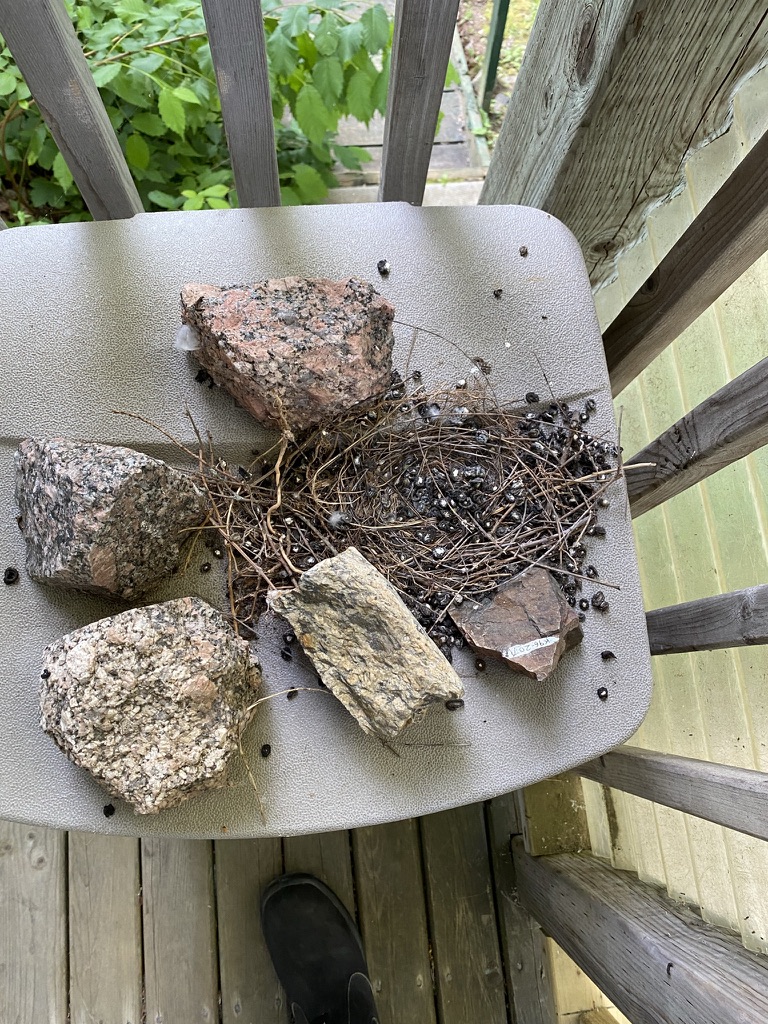
28/06/21
A different kind of welcome: the Mourning Dove is BACK on the side porch of the house where we are staying ... more babies, maybe?
FOUND, on the Rail Trail - on public land!
OMG I am going to love being here. ALSO: raspberries, CHERRY TREES, blackberries ... saskatoons! I SEE PIE. 29/06/21
The Settler Responsibility Workshop
I attended a workshop online, hosted and facilitated by The Youth Project in Halifax.
I was blown away by the level of discourse, and the intersectional consciousness these folx brought to the table. On the one hand, it made me feel old - or at least, behind in the learnings I should have been absorbing over the years, that these younger people have been seeking out an immersing themselves in. Maybe that's simply a recognition of the Privilege within which I have come to live, thanks to my partner. It's easy to miss this difficult political work when one doesn't NEED to do it as a matter of survival, as these folx do. IT doesn't diminish the value of it - FAR FROM IT - but it does serve as an extremely valuable reminder to be always cognizant of just how easy I have it in so many ways, regardless of what I may have experienced in the past. It IS in the past, and I have a level of comfort and freedom in my life that I never, ever dreamed imaginable - and that some of these folx may not ever have access to, by virtue of their skin colour (for starters).
It was also an important introduction to some of the political issues that more marginalized communities are facing HERE - its is a different political climate, and the issues are similar but different, because of the very very different (and much longer) political legacy in this place, this part of Mi'kmaki.
The questions about "HOME" were especially useful - and will be something that I will use as a basis for research and discovery in this place.
https://collectiveliberation.org/wp-content/uploads/2018/10/Indigenous-Resistance-Homework.pdf
There's also this:
https://rnt.firstnations.org
and this:
https://native-land.ca
This map has been a resource I've used for several years, and one I've got permanently bookmarked. SO valuable - a tool that taught me, just by its being, how conditioned my thinking had been - and how LITTLE I knew (and how I'd been taught NOTHING) about Indigenous territory in the place I lived.
30/06/21
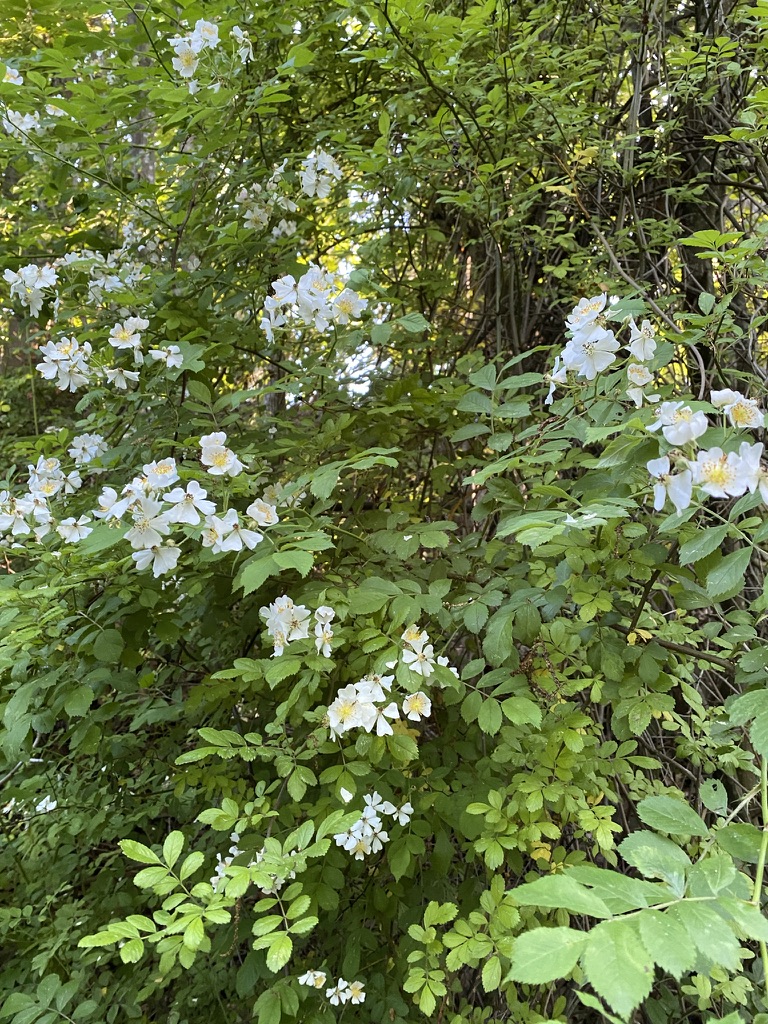
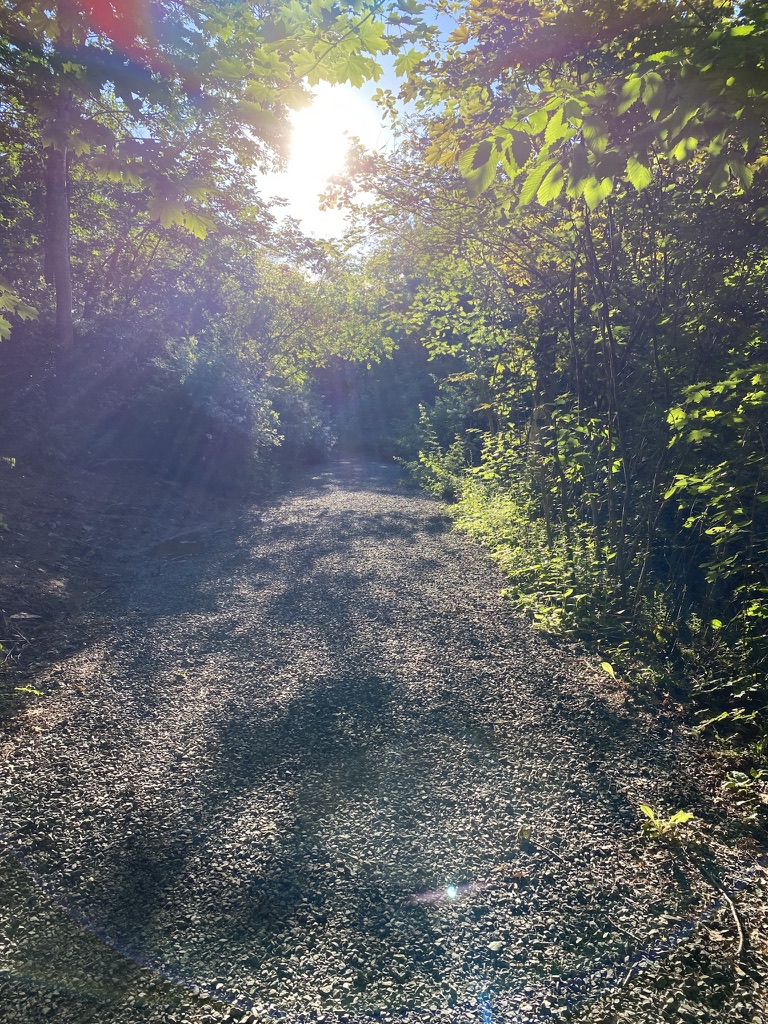
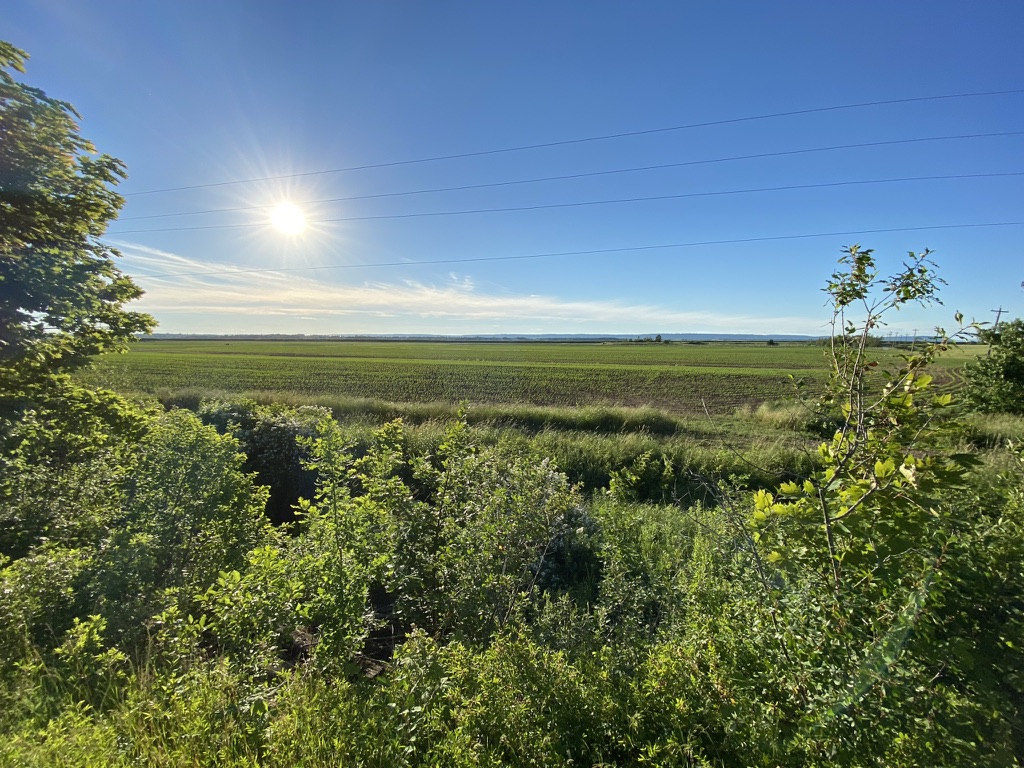
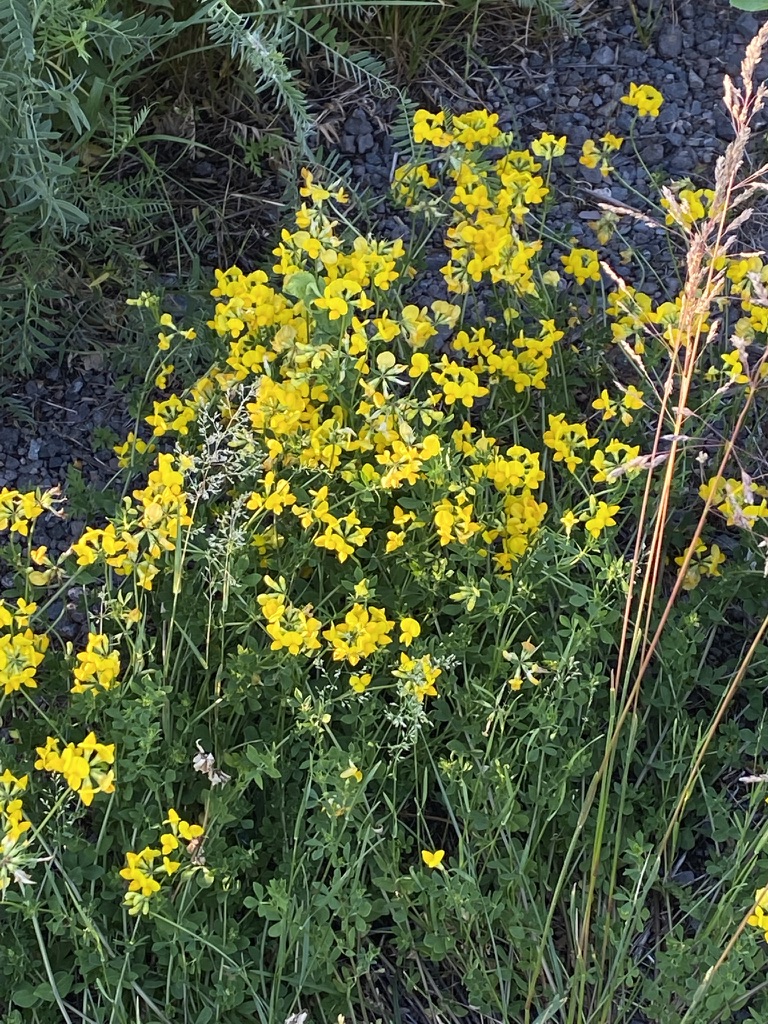
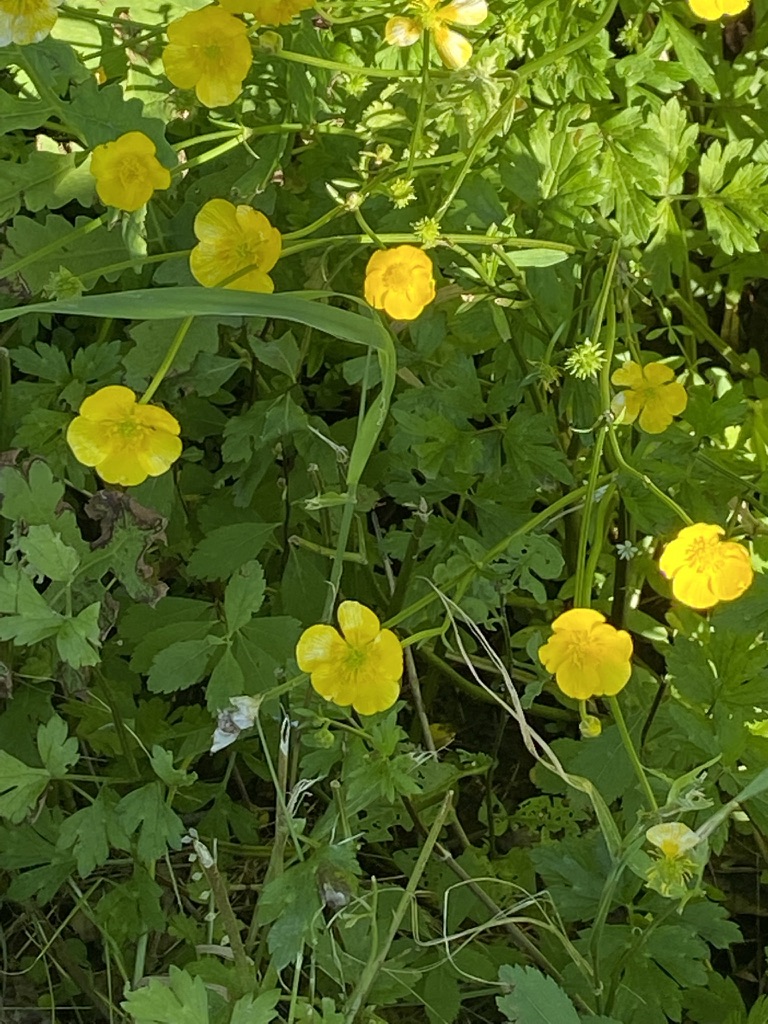

Surrounded by BEAUTY.
I am visually swamped by my daily walks - everything is EXPLODING into being.
SO much green, so much colour, and the glorious sky above. This. I NEED this right now.
Coming through so-called "canada day" was both harder and easier than I anticipated. Heartened very much by the community's response: there were a few flags and some red and white here and there - but - and this was HUGE for me - most of the houses along main street had orange shirts hung outside instead. Some with signs expressing solidarity and support for our Indigenous neighbours. It was good to see people out walking the trail too, also wearing orange shirts.
Light posts "downtown" have been decorated with strips of orange fabric, and drawings of single feathers. There is a tribute to the lost children at Clock Park in the centre of town, with a running total of the numbers, and many many shoes, donated by the community to this makeshift memorial.
Maybe some of it is just for show - the 'woke' performativity that a left leaning college town can manage to pull off at a moment's notice. But my sense is that much of this is genuine and heartfelt mourning and recognition. This is a good step in the right direction - it will remain to be seen (and only time and time in this place will tell) if these expressions of solidarity come from solid relationships with the Mi'kmaq down the road at Glooscap. Much to learn, much to observe. 1/7/21
TRYING not to PANIC.
The stupid insurance broker totally screwed up: didn't bother to READ all the information on the house we sent to get the binder letter in advance of closing.
SO - we DON'T have insurance. and it's JULY 2 TODAY!!!. FFS.
WE CLOSE (or are supposed to!) on the 6th.
Feel like this dream is slipping through our fingers.
I can't think about anything else. And the list of things to get done keeps getting longer - I waded through getting power, internet, tax account all sorted out - just to hear this today. DAMMMIT.
PECHA KUCHA!!!!
This was a GREAT exercise. It made me see connections I hadn't before! YAY for revelations!
https://www.facebook.com/grenfellcampus/videos/507316097274956/
I am also kind of astounded that I was able to get it in on time with all the house-crazies going on. Well heck.
12/7/21
PLAYING CATCH UP HERE. I haven't posted anything for a while. I just haven't been able to - no energy, emotionally or physically. SO ...
I am going baaaackkkk in tiiiimmmmeeee (like Doctor Who, my life has been all timey-wimey) ...
So it all hit the fan at once.
BUT IT ALL WORKED OUT!!
WE GOT THE HOUSE!! AND THE MOVERS ARRIVED!! AND WE ARE LIVING IN A SEA OF BOXES!! AND I STILL
HAVE SO MUCH TO DO BEFORE THE END OF TERM!!
HOLY CRAP.
BUT ...
WE GOT THE KEYS AND THE HOUSE IS OURS!!
(and needless to say, we got the insurance mess dealt with - and have a new broker!)
I am SO SORE. And SO TIRED.
But overall, very very happy. 11/7/21
was back at Sandra's to drop off and pick up some things ... DOVE BABIES on the wayy! New life, in so many ways.
12/7/21
a view of the back yard ... and
WE HAVE A TREE HOUSE!!! I've always wanted a treehouse!!
I think we are going to build a ramp to it, instead of having to climb a ladder up into it like we have to now. I want to open up a window facing out toward the water too (the side that's in the trees) - I think it would be magical to be able to sit up there on a hot summer night and feel the breeze coming off the bay.
13/7/21
We have a paper and artist statement due this week for Studio. It's also going to be used as the basis for our Final Crits in August.
I have been hammering at this for a while now, and feel like it's going to be down to the wire - but may be better for the loop of feedback and revision I've been in.
It's been really good to have everyone's input on these - I think it's made the writing stronger, for starters. Clearer, and more direct. That's been an incredible help - having these smart people to bounce this off. They are all so generous - thoughtful and thinking, and all of them are so good at asking important questions, or making really astute comments. SO very helpful. And what's even lovelier is that we're doing this for each other - there's reciprocity here, the desire for all of us to do well.
I'm also really grateful that I've had Cam's input and Andrew's coming into this last stretch - they each ask very different things of me, and that's been helpful - it's like being able to turn a stone over and over in your palm - it's the same stone, but you see it a little differently every single time you roll it around.
In some ways, the paper has been much more straightforward than the artist statement. For one thing, the paper is longer!! Hahaha ... I do like to go on so. UGH.
Seriously, though - I think what's made the paper a little simpler or easier to approach that, taking Andrew's advice, I am focussing on just ONE part of the whole project as I am currently seeing it. It's keeping me more on track for sure - and provoking me to think really hard about what I am doing and why in ONE particular part of this. So I think in the long run, as I write about different aspects of the work as it evolves, there will be conversations between these ideas and the ones to come, that will make my understanding of what I'm writing now richer later into the MFA.
It's been a deep sort of dive into one idea - I'd forgotten how much I loved writing like this - having the freedom to poke at an idea from a whole bunch of different angles, to take the time to follow threads of thinking as far as they want to go for the time being. There's an organic, rhizomatic sort of way my brain works when I'm doing this kind of writing that always takes me by surprise: the entire opening section of the paper came to be because of that tentacled sort of thinking, so that the passage wound up having an almost intimate voice. It feels odd to be comfortable writing this way in an academic context; I guess it's a function of the support I feel.
Not a bad thing at all - but a bit of a revelation! Definitely not at all used to feeling safe enough to take the "risk" of showing something less than polished and complete to ANYone in an academic setting. Some of that is simply being older and a little more sure of myself and my ideas, but it's also a reality of my experience in my undergrad and when I started my MA ... I was in an academic culture that pitted students against each other. That meant competing for everything, especially marks, and it was not up to instructors to help you get through. They were gatekeepers that maintained standards, and were actively looking for weaknesses; if you couldn't figure it out on your own, you obviously weren't good enough. Needless to say, the feel is pretty radically different in this context. Thank heaven for that!
14/7/21
I've been pondering an idea since it came up in the discussions and Q&A at the Pecha Kucha:
The idea of CARE AS A METHOD PRACTICE.
Interesting how this applies to ALL of us in this cohort, each in our own way. The care Kellyann has (and takes) to ensure community accessibility, and that her method of being and making are gentle on the planet - from the way she creates with recycled/gifted/borrowed materials, to her kickass vegan food, to her passion for cycling and bike COOPs. The care and awareness that Sally offers through her drawings and her research into body dysmorphia and the many cultures of harm that impact people and their relationships to their bodies in this culture; her love of comforting food and cooking. Sheilagh's journey to vulnerability, caring for and reclaiming her mother's history as a Mi'kmaw woman, her political efforts for the environment, for the community; how she has made space in her practice for people and their stories. Erienne is using her personal struggles to tap into the childlike need for all people to have FUN sometimes, and the potential for her work to help others; how she's recognized what art has provided her, and wants to offer that to the community.
It's something I have certainly tried to enact in my work, particularly in the last few years ... and something I am very much concerned with in this body of work - wanting to make sure that there is care expressed in each aspect of it. Worrying that it won't be as clear in some ways as I want it to be.
Sometimes I worry that the work will be perceived (regardless of intent) as some sort of 'oh woe is me, poor little Settler has the blues' thing, instead of what I want it to be: an expression of acknowledgement and recognition of my own place of privilege/responsibility/complicity in a system that has done incredible violence and harm to Indigenous and Métis people past and present, and a small gesture expressing a commitment to continue learning and doing what I can to support those communities in their journey to healing and justice.
I wonder if that's going to come through; I wonder if what I've written above is the whole of it, or even the half of it, or whether those words are in any way right or a real expression of what I want to express.
16/7/21
DONE.
The paper and artist statement for Studio is IN (for better or worse).
I think it's going to be ok - I am fairly pleased with how they both turned out in the end. I just never really know how other people are going to respond - whether I communicate my ideas and their implications as clearly as possible. Hope so.
Regardless, there's a measure of relief, that's for sure. A major assignment out of the way. ON to the next!
The days are passing too fast.
Walks home on nights like this make me so deeply grateful to be alive.
17/7/21
Where (I think) this all might go>
WEIGHT - as expressed in the print process
REFLECTION - seeing oneself through the filter of history/memory as a vehicle to new understanding
MAPPING - exposing this process as a tool for harm, that skews our relationship to place and our understanding of our relationship to the land
ERASURE - peeling the onion of history to expose the layers of other ways of knowing that are still present, but remain less known, and less valued that the dominant discourse 18/7/21
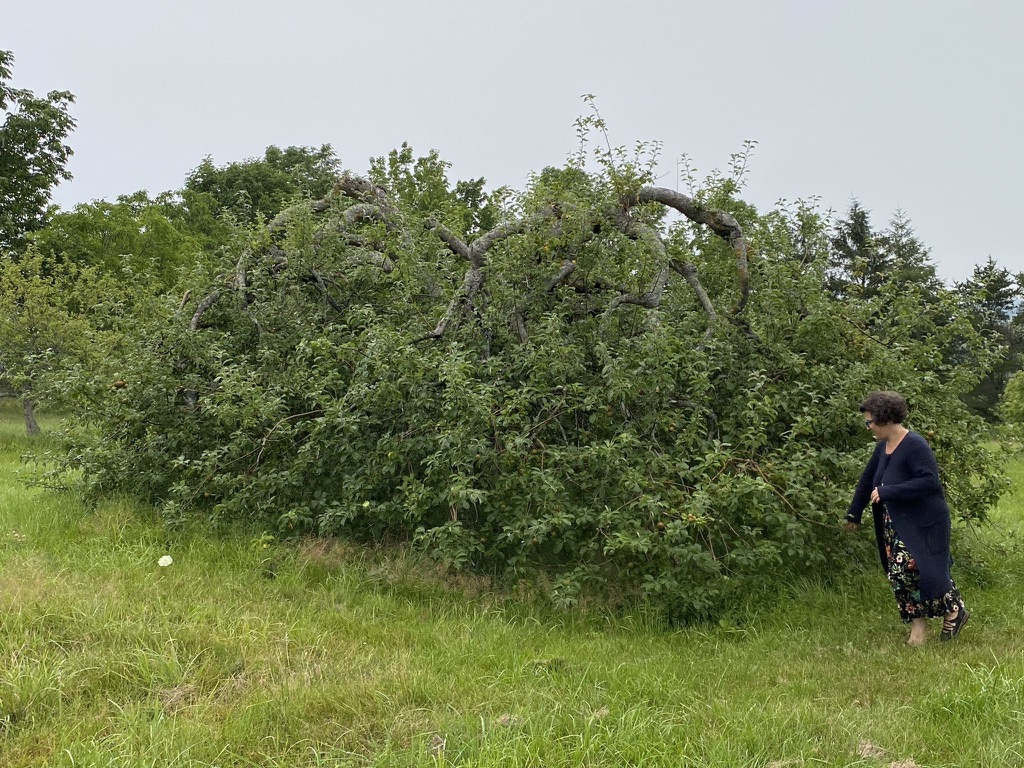
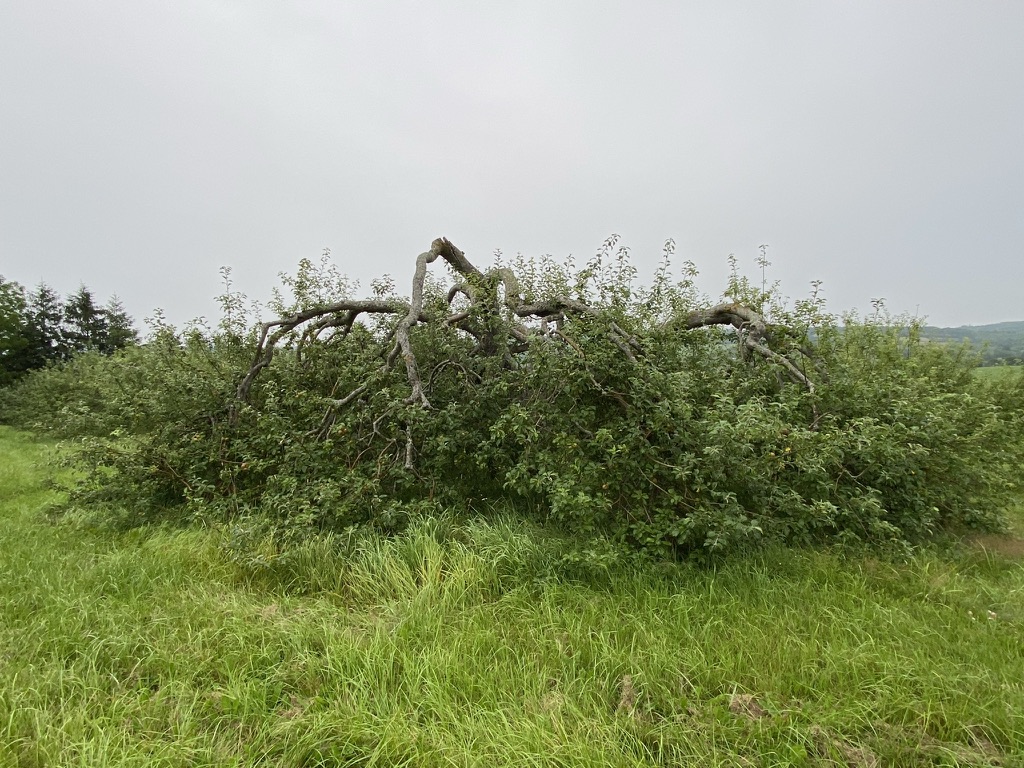
I have never seen apple trees that are over 100 years old.
This is what they look like ... and these still bear fruit! These trees are on a 34 acre hobby farm 10 minute away from our place in Wolfville.
Under those branches are green rooms, just waiting.
For scale, my friend Janette in the first picture is about 5'3" ...
She wants to trim the trees a bit, so that there is a clear entry into the space beneath the branches, and put tables and chairs inside.
It's going to feel like walking into another dimension. I can't wait!
19/7/21
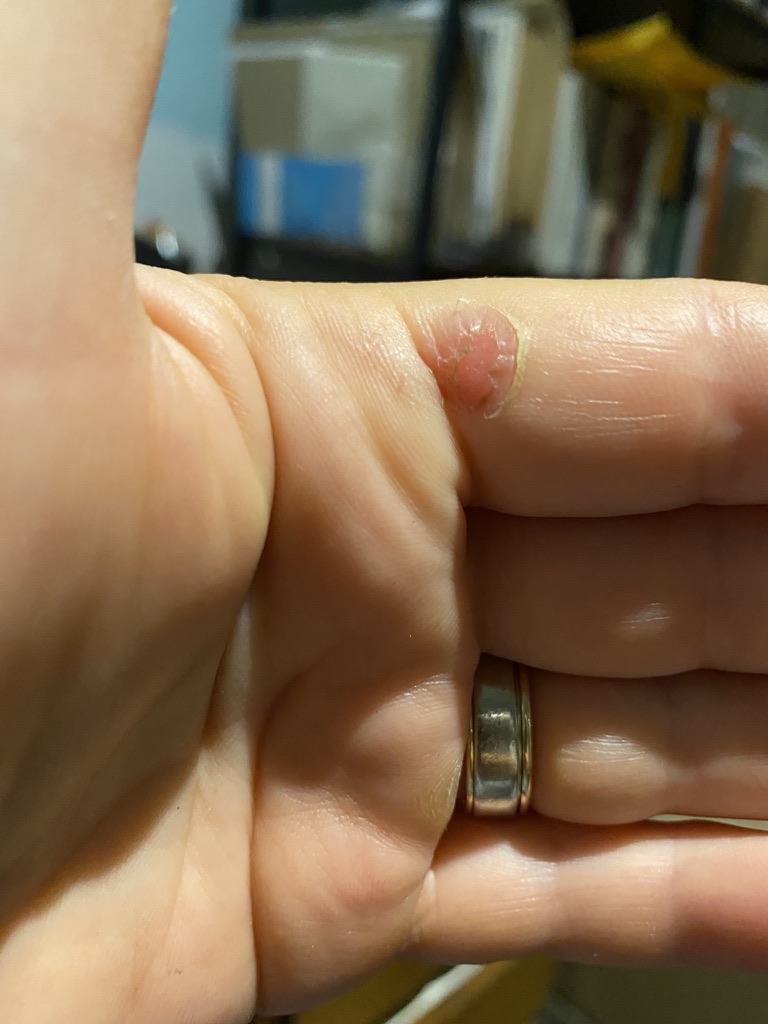
I have CITY HANDS.
WOW> I'd forgotten what this kind of yard work requires of the body ( the hands especially)! I'm used to this kind of thing when I'm working on an installation or doing things at the farm ... and for some reason it didn't sink in that this would be part of the deal here, in the new house.
I am oddly happy about this first "war wound" ... I am not sure quite WHY yet (its hurts and - like all really "good" blisters - is in a REALLY INCONVENIENT PLACE, on my dominant hand) ... maybe it means a return of some sort. That feels right ... the sense that this kind of labour means the start of a new relationship to a new place - a fisrt step toward learning and stewardship. 20/7/21
SECOND VACCINATION!!! YESSSSS!!!!!
I SWEAR, I could have kissed this woman.
She was so great - and I was SO RELIEVED. I don't care HOW I feel tomorrow - I have my second shot, and in a couple of weeks I will be able to feel just that much safer.
Especially important, since I am thinking about going back to Alberta to do some work and gather materials in advance of the Fall term.
The government continues to play fast & loose with peoples' lives out there, so I want whatever armour I can get!
21/7/21
DEAR GOD I FEEL LIKE CRAP.
No - worse than that. I feel like I got hit by a TRUCK.
EVERYTHING HURTS. Muscles, joints. My eyeballs.
This is going to be rough. Crappy timing too. I need to read, and WRITE. UGH.
22/7/21
HMMM ... an indication of things to come??
It's REALLY WET!! OMG - this is not your average Prairie Thunderstorm ... (it's lasted ALLLLLL DAAAYYYYY for starters!)
25/7/21
WOW>
Pretty much lost 2 whole days to the vaccine reaction. Managed to get a bunch of reading done, but not much else.
This paper keeps on getting away on me too --- I keep going off on tangents in the research! I'm getting really frustrated with myself.
There's a LOT here - and I have to admit, the most interesting reading really is the analysis that is tangential to the subject in question - Settler-Colonial Studies and Anthropology mostly, but some interesting ideas in architecture and planning journals too.
BUT THAT ISN"T THE POINT OF THE PAPER.
What I want to do is to look at the DLS - the basics. It's only 1500 words or so!! SHEESH.
I also wonder about my reticence with source material ... I keep catching myself avoiding the texts I have that (yes ok are admittedly dry, but) deal directly with the history of the DLS. Maybe there's a part of me that is avoiding acknowledging how deeply this inscription of boundaries and borders on the land has shaped my psyche.
I understand space in relation to this grid. And the grid has come up again and again in my work: squares, ALWAYS square format if at all possible. Even the panelled work - I'm thinking of the silk prints I've done for YORK and for Boundary|Time|Surface - yes, the individual panels are thin rectangles, but the series of panels resolves into a nearly-square format when hung properly.
And I obsess about taking photos out of airplanes. Always, that grid, and if possible, the grid as it comes into conflict with organic forms - like river beds.
I used to say that I loved working with squares and circles because they were "democratic shapes" - all equal sides, or equal distance from the center to the periphery. I am wondering about that statement now ... democratic for WHOM?? And WHO DECIDES what is "center" and what is 'margin"?
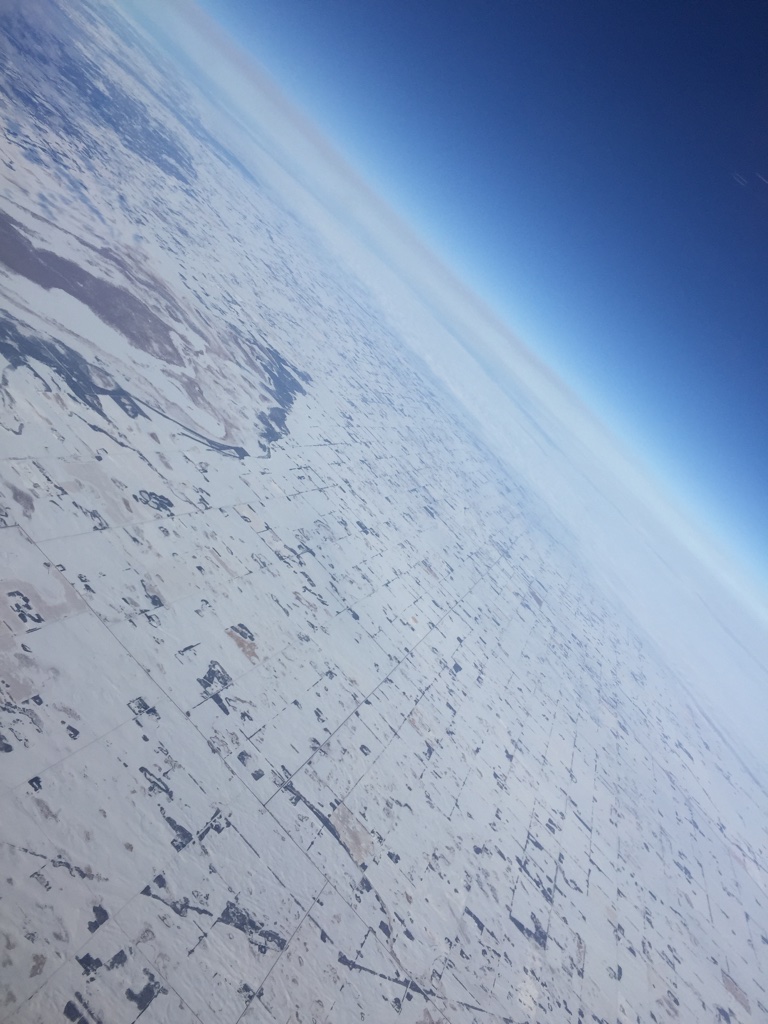
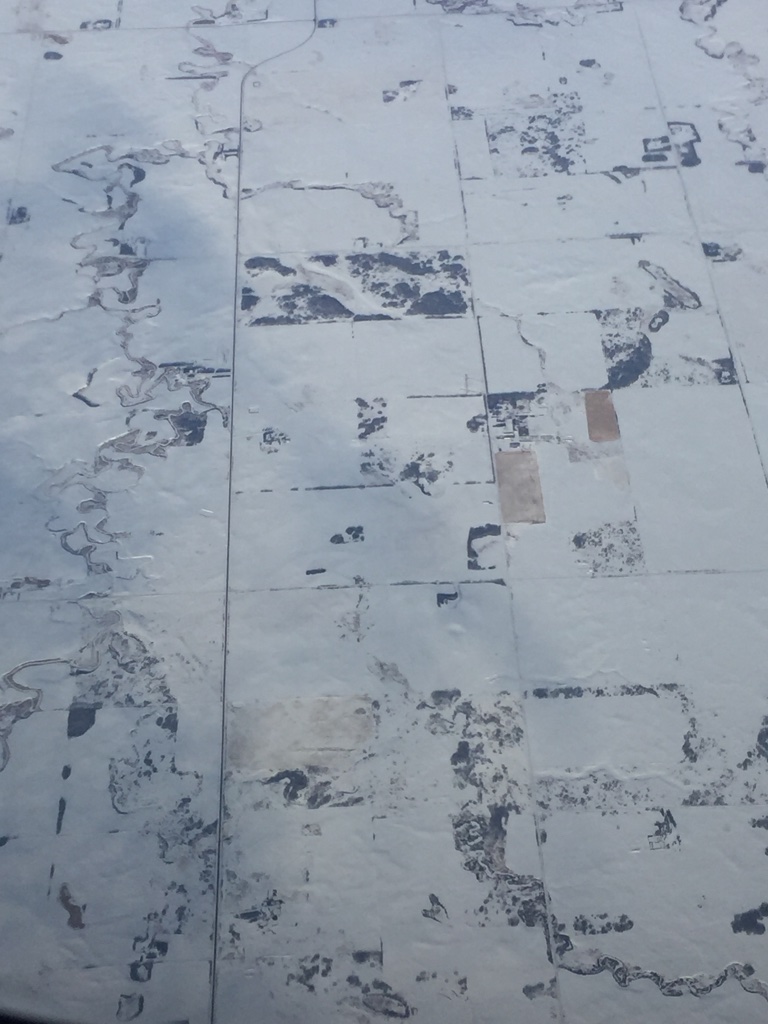
From Feb 2020 ... just before the pandemic hit.
Seeing the unconscious bias in my work through thinking about squares ....
just leaves me wondering where else it will show up. I wonder at how much I haven't seen still ... when (or whether) I will be able to dig myself out of this far enough to catch it more readily.
That's the point, isn't it? It's NEVER done - just more readily apparent.
26/7/21
OK!
Think I've finally got the paper worked out!!
Moved a section on measurement and marking the landscape into an appendix.
It was one of the rabbit-holes I went down that was too important to leave out - but wasn't absolutely central to the paper. Important details there, especially in the images I wanted to incorporate for reference - I felt they aded depth to the discussion.
SO - appendix it is! Get me down to a reasonable word count for the paper, and still managed to include it! YAY!
Happy that Ingrid was ok with that strategy.
... one more down ... CRIT still ... light at the end of the tunnel (of moving boxes!) ...
28/7/21
Image from:
Manual Shewing the System of Survey of the Dominion Lands, with Instructions to Surveyors, 1883.
I've been ruminating on the violence of the DLS.
The violence in the way the survey was marked in the land.
The violence it did in the displacement of Métis and Indigenous people: spikes hammered into packed mounds of earth or stones. Coordiantes carved into the trunks of living trees. Living trees left rooted in the ground, but cut off into pillars, squared off (SQUARES AGAIN!!!) - and marked with survey coordinates.
The violence of the language in the field notebooks and maps: landscape and the natural world - all the things living on and in the land - reduced to commodities. Trees catalogued and marked on maps - what would be good for building, what for clearing. Where the open prairire was - good for grazing. And always, the farm in mind: tilling soil, planting crops - so, "soil, 1st class" was proffered. A clue to where best to pick "your" land for settling.
This is an extractive violence, and it is IMPOSSIBLE to get away from. It is in everything now. It is a function of capitalist economics in Settler-Colonial contexts.
How best to express that violence, and my own resistance to it as a Settler?
Dialogue, not rhetoric.
Invitation, not explication.
Listening, not speaking.
Making room for other voices to be heard.
Where are the invitations in the work? Where is there room for other voices, and where is it best to relinquish control of the process and the result? And what does it mean to STAY IN MY LANE - I cannot and must not presume anything. And I need to be conscious at all times of where my bias may lay hidden, and potentially sabotage the potential for dialogue: new conversations that I really hope to stimulate.
Much to weigh and think through. Good thing the Crit is coming up ... I think the feedback may help. 30/7/21
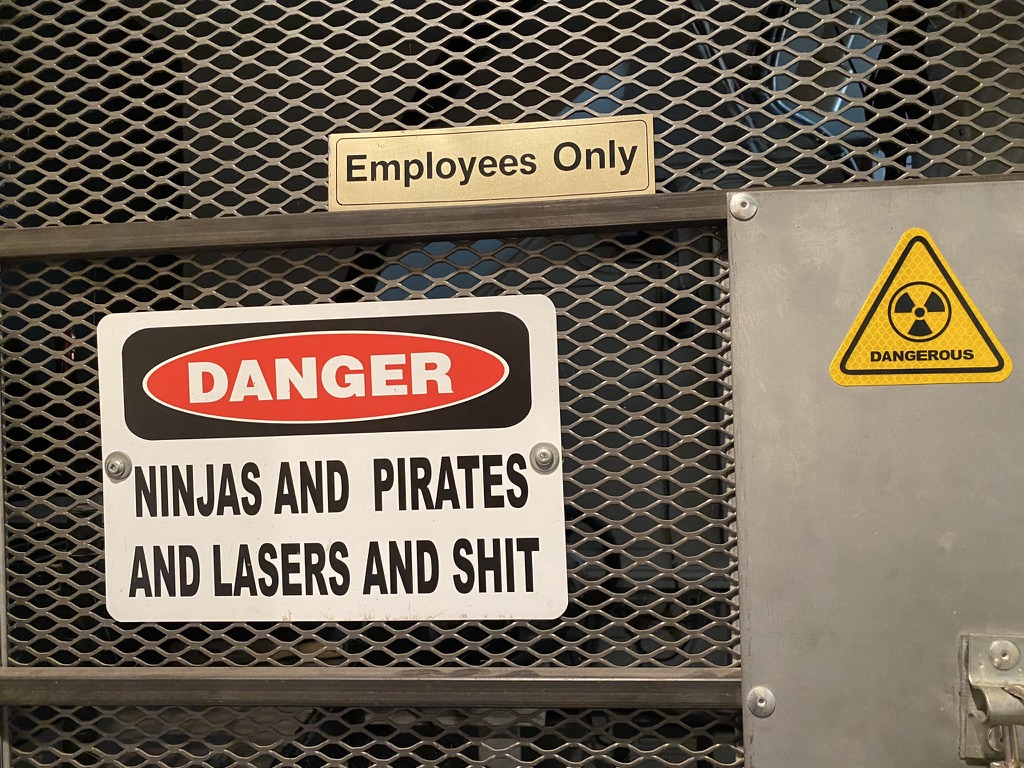
This place makes me smile.
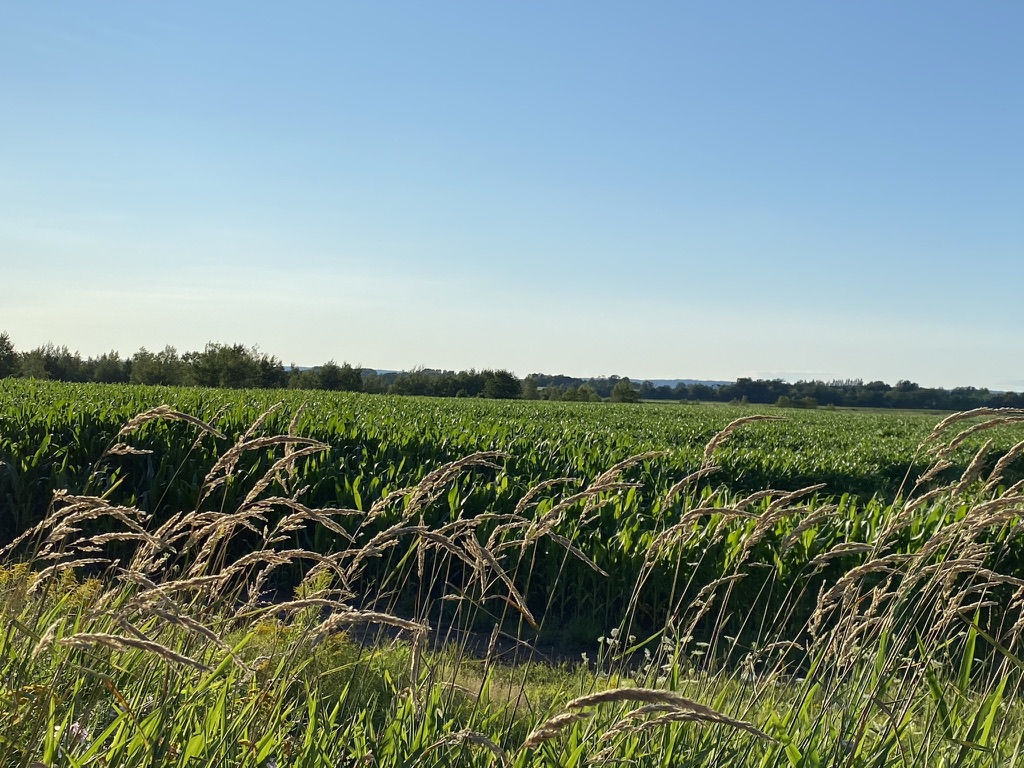
How different this landscape is.
I am always thrown by the lushness, by how quickly things grow here.
By how many plants I canNOT identify ... I am at once a CFA (come from away), and a Newbie, and yet - I feel more at home here than I've EVER felt, anywhere.
Maybe that's about being new - oddly. Or not oddly: I am more at home here because, perhaps, there are no expectations - little history shared - between me and this place.
I can ask questions, and know that there will be understanding in the answer: I don't know and am not expected to. That is a liberating position to be in emotionally and psychologically.
To be always be in beginner's mind - and to have inquisitiveness rewarded with kindness. How lovely that experience is.
There are also few expectations framing my interactions here: I just am, and so are the people around me, so is the land and all the beings in and on it. That also is liberating, at least for now.
I do not know much of the history of this place - and it is my responsibility to learn now that I live here. So, I rather expect that I will discover things that will take the freshness and veneer of beauty from the place. This is to be expected.
NO place with such a long Settler history can be without its own pain and scars. That is the nature of that reality. Complicated here, too, by the treatment of several groups of people - all appallingly.
The historical - and ongoing - marginalization and discrimination faced by Black people.
The complicated relationship between the state and the Mi'kmaq, and the ways in which the Peace and Friendship treaty has never been properly honoured by the Settlers or their governments - and how that shapes the ongoing conflicts about the fishery here.
The treatment of the Acadians. Their expulsion, starvation, dispossession at the hands of the English. That's a long-burning ember just under the surface here.
These are all resentments, traumas, injustices stretching back generations.
Things one can see perhaps slightly more dispassionately, for a lack of history in this place. I don't know - I guess I will find out.
But I do know a few things: that the work I have been doing as a Settler artist, coming to terms with my own responsibilities in relation to the place of my birth (and much of my life) is a start towards knowing THIS place. I sometimes feel like it was necessary for me to be doing this work, right now, in order to be open enough to come to this place so that I could begin to learn what it means to be a Settler HERE> that without starting this work on the Prairies, I would not be properly prepared for the complicated work embodied in this place - and that I would risk falling into (more) unwitting traps set by ignorance, and the nuances of privilege I cannot yet see.
Process, always process.
1/8/21
31/7/21
CRIT TODAY!!!
A little nervous - BUT - I feel OK about where I am at.
That in itself is a HUGE breakthrough. I feel ok about what I have accomplished so far, and (what's even better) I feel fine about NOT having answers to many of my questions.
Maybe, finally, I am learning how to be a little gentler with myself, and a little more able to see the good in what I am doing. That's progress I think.
2/8/21, morning
Well ...
That went pretty well, I think. Not sure exactly what I expected: maybe more of a grilling? OR maybe I was just well-prepared?
In any case - I'm not going to overthink it - it's done and for better or worse, it can't be changed! But I do feel that the conversations were both productive and illuminating, and that I was able to answer or comment in my turn in a fairly cogent fashion. AND ... I felt OK about not knowing the answers to every question that was raised: or more clearly, I felt comfortable asking questions at the end of the presentation for which I had no answers, or which were troubling me, and for which I needed direction.
That was a lovely think, actually. To have that kind of conversation: where there is real dialogue, and that give-and-take really did go both ways. I really love this process, and am so very grateful for the opportunity.
The crit was also a good lesson for me in trusting my gut - the things I was uncomfortable with (some of the questions I had about specific aspects of work I want to pursue) were things that I NEEDED to be uncomfortable with: there are some minefields in the kinds of work I am contemplating, and my gut was telling me that there were problems. And it was right - confirmed through the generous thinking and guidance offered by Cam and Robert and Andrew.
One of those situations where you basically know the answer already, but aren't sure WHY exactly, what the specifics are - just that there's something niggling on the periphery. The confirmation - and the suggestions for considering the problems in new ways - were both validating.
I'm also really happy that the print works are being so well received. That is also validating - since I am quite a newbie when it comes to printmaking, so it felt like something of a risk to take at the MFA level, and especially with Andrew as my studio instructor, since he's a print person! I guess the stuff I've learned at SNAP and on my own has actually paid off in earnest. SO that's a nice feeling.
It remains to be seen how much the work will shift over the next few months. It might, drastically. Some of that depends, in part, to what happens in Alberta with respect to COVID-19, and the horrible decisions being made about public health and safety. The numbers are already swinging back up (Stampede anyone??) and with the Delta variant gaining traction, it might be a real nightmare.
If that scenario plays out, I'm not sure that I really want to go back West at the end of the month. But I need to for other reasons - medical and dental to take care of, for starters. But it is a growing question. I'm just so utterly thankful I was able to get my 2nd dose here in Nova Scotia. The vaccine will have had ample time to take full effect by the time I am supposed to fly.
I guess I'll se over the next little while.
3/8/21
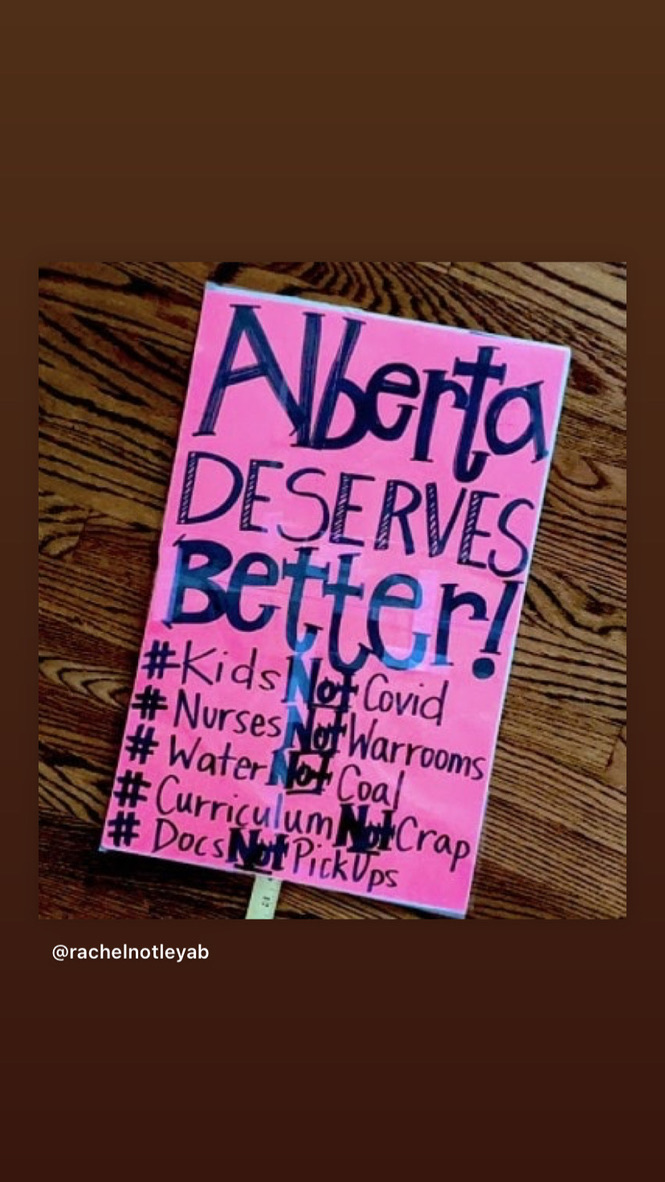
NUFF SAID.
4/8/21
YET another reason that I am happy we are working toward being permanently out HERE in the next few years.
You know it's getting BAD when people are protesting the REMOVAL of restrictions!
Rain.
These are "showers" here ... not a storm, not a downpour.
It would be flooding the streets were this Edmonton - but it's not Edmonton. IT also feels like +32 outside ... too hot for a rain coat.
The number of people I have seen walk by today, no umbrella, no jacket - just calmly getting soaked, because it's the sensible thing to do - is truly fascinating. The decision to accept rather than rail, rather than try to change the inherent is-ness of this place, is so refreshing. Be the willow, not the stone.
A very good day to edit images for the laser, and edit a few little videos.
5/8/21
I've been digesting the conversation from the Crit - looking forward to getting Andrew's notes from it as well, as that will have more to chew on, to be sure.
But today, I was pondering something Cam said: about being flexible. Thinking through the learnings I have already, what I've been doing in relation to the specificity of the Farm ... and not being as rigidly tied to that one place. Considering how I can best make work that says what I want to say, and incorporate THIS place, THIS moment - which is not what I was thinking about at all 6 months ago.
I had been thinking of this Alberta-based work as a leave-taking, in some ways. A thinking through of the unbearableness of the place and it's beauty, and my love of the land ... in relation to all that hurts the soul on so many levels there. The raw wound that the place is for me on a general level, the dislocatedness that comes with the recognition that I can write that, and in the same instant know I love some specific places, like the Farm, and some specific people who live in Edmonton and elsewhere in the province. I love those places and people deeply, and always will. A deep dive to understand why I need to leave, now, after so long. Why I am done with it, despite the love.
Maybe it's because of the love that I have to leave. That feels true as I write it, but I am not sure at all what it means. There's the kernel of something there.
But in any case: flexibility. Thinking through how this work could open up a bit, be able to incorporate what I am experiencing here in Nova Scotia, the unknown/new place/ where I am/who am I here AND some of what I have been drawn to create about the Farm. What commonalities need to be drawn out, so that the differences (although stark in some respects) also say something about the threads that connect one place and another ... .
The settler experience is so very different out here; the history (and the length of European occupation of these lands) makes it so for starters. That there are no treaties out here (that is, the Prairie numbered treaties deal with territory/land in a specific way, and the Mi'kmaq never surrendered land (https://en.wikipedia.org/wiki/Miꞌkmaq) in exchange for promised benefits from the colonial government (like health care and education ... that turned out well on the Prairies!).
That's a profound difference; it also makes the racism & economic hardship more egregious. It's also complicated by the layers of time and politics and the interactions of French and English colonial forces here, in addition to the complexities of Black experience.
SO VERY MUCH I do not know about this place... so, I'd best get reading! When I look at how much I've learned in the last 8 months about the DLS and homesteading history, it takes me by surprise ... there's so much behind the small amount of work I've got to show for it. It feels infinitely more complex out here - so it's got me feeling a little overwhelmed to consider ... but it needs to be thought about and thought through; I haven't done that yet, and it will take time. There's also the Mi'kmaq connection to Newfoundland, which is obviously connected indirectly to this shifting of gears. I know some of that story from my basic research for Boundary|Time|Surface - but the concerns of that project were sideways to this one ... that one was very specifically about time and knowledge, especially scientific knowledge, but there were registers in the project to do with mapping and understanding the self and the body in relation to the land.
SO, yes, east and west have been connected for me in several ways for a number of years. It's just a matter of hitting on the right things for THIS moment to weave them together again, in new ways.
It's kind of flipped the other way around this time. Hmm - that's interesting in and of itself. I wonder if that's a clue to where to go with it. I need to go for a LONG LONG walk and think. A lot.
Glad there's a break between semesters.
There are some visual breadcrumbs for me to follow though ... bigger, broader visual gestures that might work to connect these places and this experience ...
FENCES AND BORDERS & MAPPING especially ... both of which are about access/permission/territory/claiming/the body in space/understanding where one IS on the land/understanding WHO one is in relation to the land ... in.out.margin.center.exclusion.inclusion ... WHICH BODIES BELONG? WHERE DO THEY BELONG? WHO GETS TO MAKE THE RULES?
HOW do those rules get expressed? What kinds of documents? How are the stories being told, of bodies in space and in relation to one another??
How are these questions related to the ideas of WEIGHT/REFLECTION/MAPPING/ERASURE?? That all seems to fit together well still ... but it remains to be seen how much that changes.
I guess I know what I'm doing for the rest of the summer and the Fall term, for sure!
5/8/21
https://yorkhotelproject.wordpress.com/
https://sydneylancaster.com/portfolio/macromareal/
We've been calling these "Car Alarm Birds" - the name's going to stick, even though we know they are Cardinals ... RIDICULOUS.
and so Lovely. 6/8/21
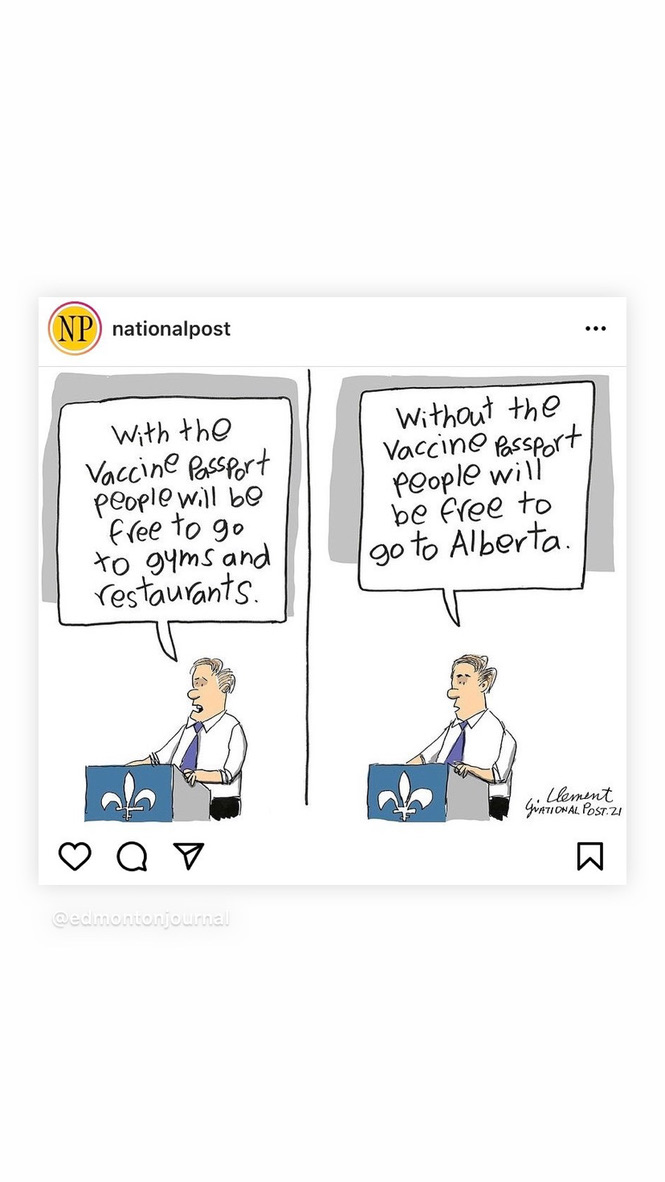
SO.
It's the end of term today ... and a time to look ahead to what comes next, for the work, for life.
I don't usually pay any attention to the National Post - it tends to be too right wing/big biz/capitalism is good for my tastes (by a long shot). But when the NP post a cartoon like this!! Holy Hell BATMAN ... yes, it's as bad as I feared.
The violent shortsightedness of Alberta's recent policy announcement has the NP looking down it's nose ... that's saying something, given the relatively positive coverage they have given to the pro-oil lobby coming out of Alberta ... . I wonder at the blindness: if right-leaning, pro-business interests are saying this is a dumb move, you'd think Kenney would listen.
But apparently not.
This raises some difficult questions for the coming weeks - I really do need to go back to AB - and I am double-vaxxed now (thanks, NL and NS!! I won't forget this, EVER!!) But it's still a worry.
I am reminded of the old adage: You reap what you sow. I think the Alberta government and their base will be seeing the reality of this in spades, very soon.
AND
That also means that if I sow safety, I will reap it (with a little luck, minimal contact with others, and all the usual first lockdown precautions). Going to have to make sure I spend as much time as I can either alone or out on the farm. I'm ok with that ... at least the numbers in Edmonton and area are FAR less than in Calgary.
Interesting choices. We've all come so far - especially out here, in NL and NS! The difference in attitude and approach is truly striking. Brings home all the ways in which I don't really belong out there any more - and never did.
6/8/21
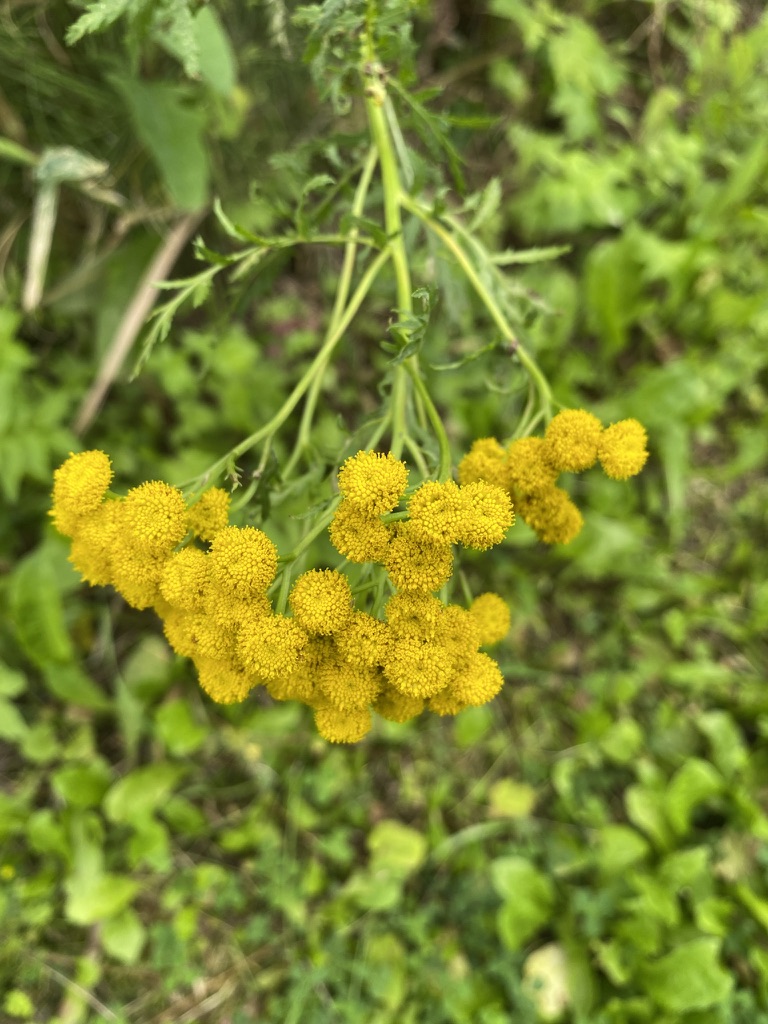
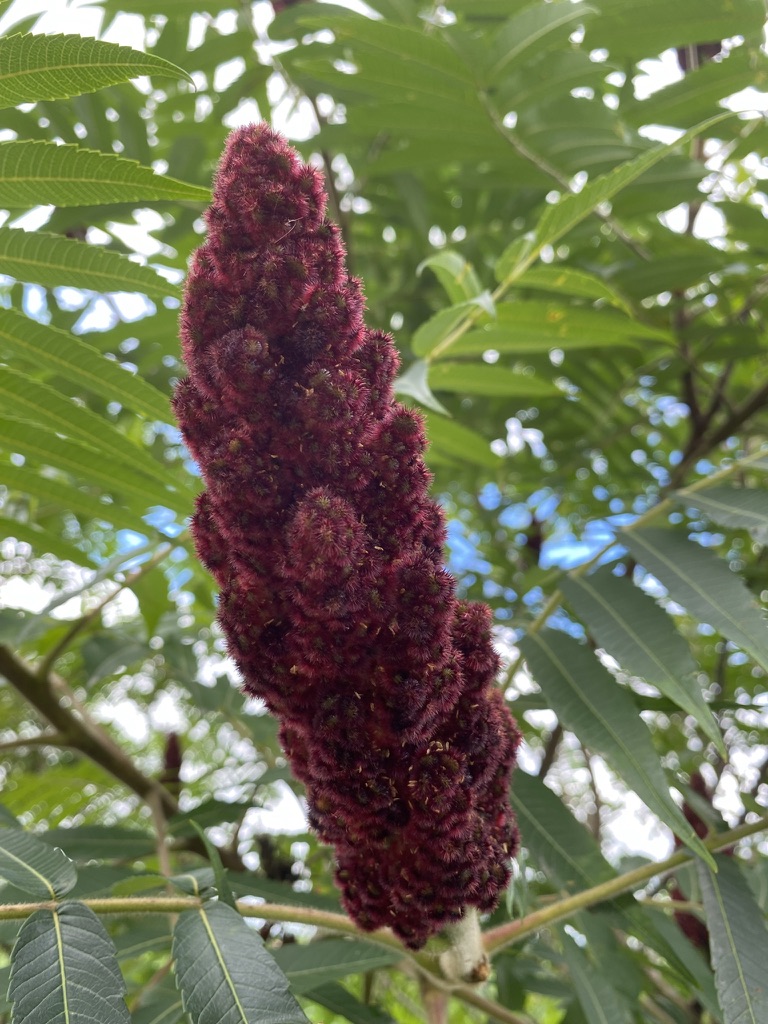
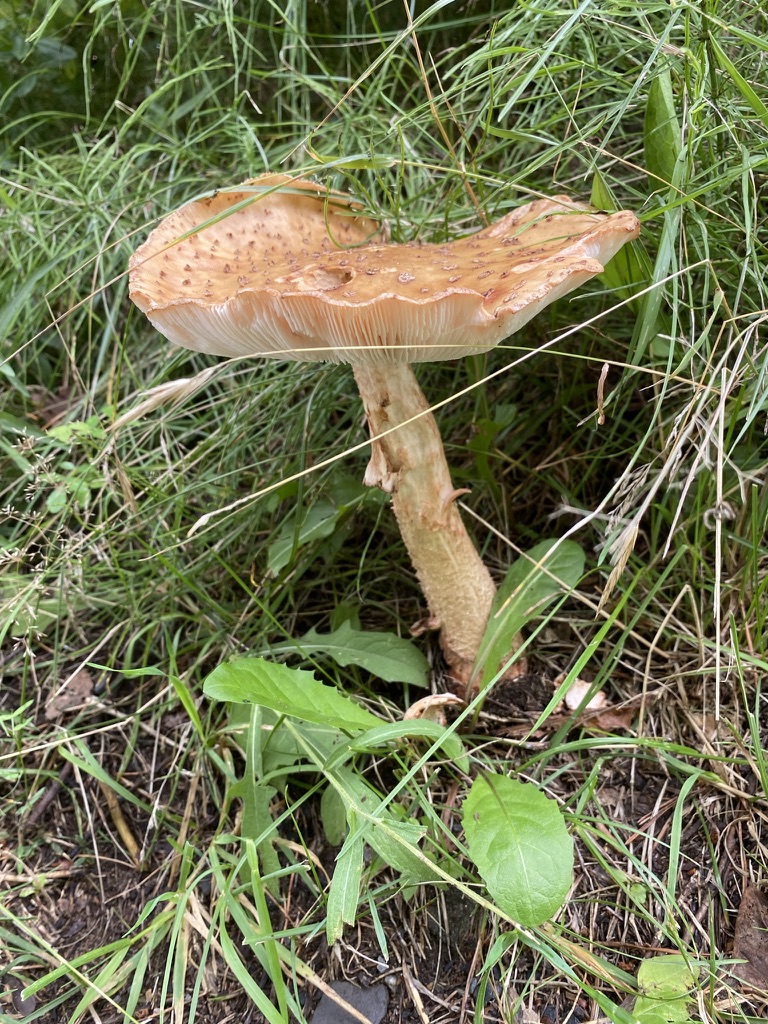
I had to go into town to get some groceries today, and took the Rail Trail to and from the house.
What a luxury - to be able to walk along this path, away from traffic (excepting other walkers and cyclists) - and take a little time to appreciate the lushness all around us here. The more I walk the more I learn the more there is to entice the eye and feed ideas.
I've been pondering directions, in light of discussions in the Final Crit, comments from Cam, and my own thinking about expanding (shifting) the frame of reference for the work to come.
There's an abundance of Tansy on the Rail Trail - and it is classified as a noxious weed out here. PERFECT> Tansy is a good dye plant, so I am going to see what I can do with it as a material for ink making! This is PLACE + STEWARDSHIP, so it aligns perfectly with that aspect of the ideas I've been working with.
Back to matters of CARE as integral to practice.
I also think there's Sumac growing wild (?) ... so I need to see what I can do with that! That red just makes me smile - and if I can get something even close to that, I'll be overjoyed! (Not to mention that I want ot do research on Sumac anyway, because I cook with it all the time. If I can HARVEST it here and/or GROW it, AND make ink from it, my brain just might explode with HAPPY. And I want to find out if it's native, or an import, and what it's place is in the ecosystem.
All kinds of mushrooms sprouting here too ... all shapes and sizes, and NONE of them familiar! So I need to get to know a mycologist ... or at least find out if there's a forager's club in town. There's some interesting things to be done there too ... again, food and colour.
And there's no shortage of things to do other-wise as well:
I have a bunch of lino just waiting for my knives: this is tomorrow's priority, since it's going to pour (again) ... and I have some phrases selected from maps and notebooks to carve. I'll be able to use the BIG etching press at SNAP this winter to print these, and that will allow me to use the wide margins I prefer for these prints - they have so much substance with a wider frame, it really is pleasing - it pushes the eye into the details of the background in an interesting way. SO that's sorted, and should be in good shape in the next few months no problem; I'll have all of the plates done by the time we head to Alberta in January for John's teaching (assuming that happens).
So that's a start, it's something, it's moving toward resolution ... and the rest, the rest will come.
I just have to trust that, and stay open, and sit with the recognition that NOT knowing is a very good place to be at this point. The discomfort of being unsure can be a VERY productive place ... and I need to reclaim some of that child-mind for myself over the next while.
I need to PLAY. And see what comes of it.
6/8/21
End of INTERSESSION 2021